Motorola Mobility T6EK1 Portable PCS GSM Transceiver w/ Embedded Bluetooth User Manual UG C330 GSM
Motorola Mobility LLC Portable PCS GSM Transceiver w/ Embedded Bluetooth UG C330 GSM
Exhibit 8 Users Manual

APPLICANT: MOTOROLA, INC. FCC ID: IHDT6EK1
EXHIBIT 8
INSTRUCTION MANUAL
A preliminary draft copy of the Users Manual follows:

START HERE >
A1000 Communicator
UMTS
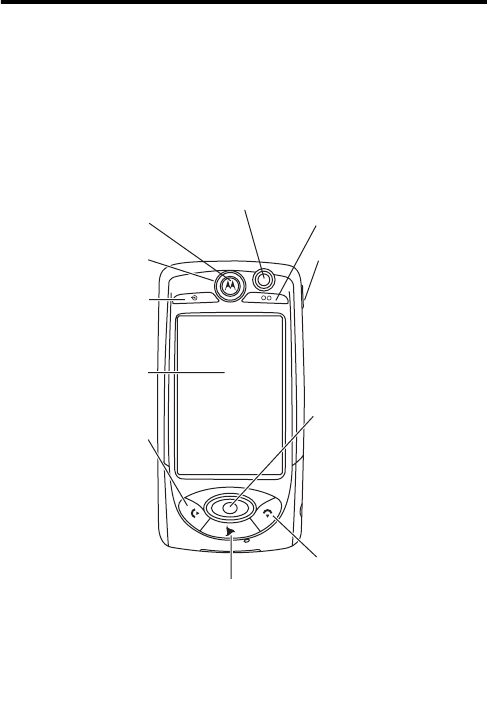
1
Draft
Welcome
Welcome to world of Motorola digital wireless
communications! We are pleased that you have chosen the
Motorola A1000 multimedia communicator.
Status Light
Touchscreen
Earpiece
Navigation Key
Push center
button left, right,
up, or down to
move through
items. Press
center button to
select
highlighted item.
End Key
Press and
release to end
calls and to
display phone
dial pad.
Camera (Point 2 Point)
Two-way video
conferencing
Send Key
Press to make
and answer
voice or video
calls. When not
in a call, press to
display call
history.
Game A Key
Game Key B
3 Key
Speakerphone
Key
2
Draft
Motorola, Inc., Consumer Advocacy Office
1307 East Algonquin Road
Schaumburg, IL 60196
1-800-331-6456 (United States)
1-888-390-6456 (TTY/TDD United States)
1-800-461-4575 (Canada)
www.motorola.com
(United States)
www.motorola.ca
(Canada)
MOTOROLA and the Stylized M Logo are registered in the US Patent &
Trademark Office. All other product or service names are the property of
their respective owners. The Bluetooth trademarks are owned by their
proprietor and used by Motorola, Inc. under license.
© Motorola, Inc. 2004.
Software Copyright Notice
The Motorola products described in this manual may include copyrighted
Motorola and third party software stored in semiconductor memories or
other media. Laws in the United States and other countries preserve for
Motorola and third party software providers certain exclusive rights for
copyrighted software, such as the exclusive rights to distribute or
reproduce the copyrighted software. Accordingly, any copyrighted
software contained in the Motorola products may not be modified,
reverse-engineered, distributed, or reproduced in any manner to the
extent allowed by law. Furthermore, the purchase of the Motorola
products shall not be deemed to grant either directly or by implication,
estoppel, or otherwise, any license under the copyrights, patents, or
patent applications of Motorola or any third party software provider,
except for the normal, non-exclusive, royalty-free license to use that
arises by operation of law in the sale of a product.
Manual number: 68XXXXXX61

3
Draft
Contents
Welcome
. . . . . . . . . . . . . . . . . . . . . . . . . . . . . . . . . . . . . . . 1
Contents
. . . . . . . . . . . . . . . . . . . . . . . . . . . . . . . . . . . . . . . 3
Safety and General Information . . . . . . . . . . . . . . . . . . . . 9
European Union Directives
Conformance Statement . . . . . . . . . . . . . . . . . . . . . . . . . 15
Getting Started
. . . . . . . . . . . . . . . . . . . . . . . . . . . . . . . . . 16
What’s in the Box? . . . . . . . . . . . . . . . . . . . . . . . . . . . . . 16
About this Guide . . . . . . . . . . . . . . . . . . . . . . . . . . . . . . . 17
Optional Features . . . . . . . . . . . . . . . . . . . . . . . . . . . 17
Optional Accessories . . . . . . . . . . . . . . . . . . . . . . . . . 17
Installing the USIM Card . . . . . . . . . . . . . . . . . . . . . . . . 17
Installing the Memory Card . . . . . . . . . . . . . . . . . . . . . . 19
Battery Use . . . . . . . . . . . . . . . . . . . . . . . . . . . . . . . . . . 20
Installing the Battery . . . . . . . . . . . . . . . . . . . . . . . . . . . . 21
Charging the Battery using the Travel Charger . . . . . . . 22
Charging the Battery using the Desktop
Charging Cradle . . . . . . . . . . . . . . . . . . . . . . . . . . . . . . . 23
Turning Your Communicator On and Off . . . . . . . . . . . . 23
Setting Up Your Communicator for the First Time . . . . . 24
Making and Answering Calls . . . . . . . . . . . . . . . . . . . . . 24
Making a Call . . . . . . . . . . . . . . . . . . . . . . . . . . . . . . . 25
Answering a Call . . . . . . . . . . . . . . . . . . . . . . . . . . . . . 25
Using Your Communicator
. . . . . . . . . . . . . . . . . . . . . . . . 26
Communicator Display . . . . . . . . . . . . . . . . . . . . . . . . . . 26
Using Touchscreen Control . . . . . . . . . . . . . . . . . . . . . . 27
Using the 8-way Navigation Key . . . . . . . . . . . . . . . . . . . 27
Using the 3 Key . . . . . . . . . . . . . . . . . . . . . . . . . . . . . . . 27
Using the Game Keys . . . . . . . . . . . . . . . . . . . . . . . . . . . 28
4
Draft
Game Key A and Game Key B . . . . . . . . . . . . . . . . . . 28
Opening Applications . . . . . . . . . . . . . . . . . . . . . . . . . . . 28
Folders . . . . . . . . . . . . . . . . . . . . . . . . . . . . . . . . . . . . . . 30
Switching Folders . . . . . . . . . . . . . . . . . . . . . . . . . . . . 30
Filing New Entry in Folder . . . . . . . . . . . . . . . . . . . . . 30
Moving Entry to a Different Folder . . . . . . . . . . . . . . . 31
Adding, Renaming, and Deleting Folders . . . . . . . . . . 31
Status Indicators . . . . . . . . . . . . . . . . . . . . . . . . . . . . . . 31
Entering Text . . . . . . . . . . . . . . . . . . . . . . . . . . . . . . . . . 34
Handwriting Recognition . . . . . . . . . . . . . . . . . . . . . . 34
Virtual Keyboard . . . . . . . . . . . . . . . . . . . . . . . . . . . . . . 36
Using AGPS Location Information . . . . . . . . . . . . . . . . . 36
Limitations of AGPS . . . . . . . . . . . . . . . . . . . . . . . . . . . . 36
Home Screen
. . . . . . . . . . . . . . . . . . . . . . . . . . . . . . . . . . . 38
Displaying the Home Screen . . . . . . . . . . . . . . . . . . . . . 38
Screen Contents . . . . . . . . . . . . . . . . . . . . . . . . . . . . . . 38
Personalizing Home Screen . . . . . . . . . . . . . . . . . . . . . . 40
Calling Features
. . . . . . . . . . . . . . . . . . . . . . . . . . . . . . . . 41
Opening Phone Application . . . . . . . . . . . . . . . . . . . . . . 41
Displaying Your Phone Number . . . . . . . . . . . . . . . . . . . 42
Using the Internal Speakerphone . . . . . . . . . . . . . . . . . 42
Adjusting the Volume . . . . . . . . . . . . . . . . . . . . . . . . . . . 42
Making a Voice Call . . . . . . . . . . . . . . . . . . . . . . . . . . . . 43
Dialing with the Keypad . . . . . . . . . . . . . . . . . . . . . . . 43
Dialing Stored Phone Numbers . . . . . . . . . . . . . . . . . 43
Redialing Failed Voice Calls . . . . . . . . . . . . . . . . . . . . 43
Making a Video Call . . . . . . . . . . . . . . . . . . . . . . . . . . . . 43
Making a Video Call to Another Phone . . . . . . . . . . . 44
Making a Video Call to a Computer . . . . . . . . . . . . . . 45
Calling an Emergency Number . . . . . . . . . . . . . . . . . . . 46
Using AGPS During an Emergency Call . . . . . . . . . . 46
Dialing the Call . . . . . . . . . . . . . . . . . . . . . . . . . . . . . . 48
5
Draft
Answering Calls . . . . . . . . . . . . . . . . . . . . . . . . . . . . . . . 48
Switching to Airplane Mode . . . . . . . . . . . . . . . . . . . . . . 49
Turning off Call Ringing . . . . . . . . . . . . . . . . . . . . . . . . . 49
Messages and Email
. . . . . . . . . . . . . . . . . . . . . . . . . . . . . 50
Setting up Messaging Accounts . . . . . . . . . . . . . . . . . . . 50
Email . . . . . . . . . . . . . . . . . . . . . . . . . . . . . . . . . . . . . . 50
MMS and SMS . . . . . . . . . . . . . . . . . . . . . . . . . . . . . . 51
Opening Messaging Application . . . . . . . . . . . . . . . . . . . 52
Creating and Sending Messages . . . . . . . . . . . . . . . . . . 53
Email and SMS . . . . . . . . . . . . . . . . . . . . . . . . . . . . . . 53
MMS . . . . . . . . . . . . . . . . . . . . . . . . . . . . . . . . . . . . . . 54
Receiving and Reading Messages . . . . . . . . . . . . . . . . . 57
Contact List
. . . . . . . . . . . . . . . . . . . . . . . . . . . . . . . . . . . . 58
Opening Contacts Application . . . . . . . . . . . . . . . . . . . . 58
Adding Contacts . . . . . . . . . . . . . . . . . . . . . . . . . . . . . . . 59
Adding New Fields . . . . . . . . . . . . . . . . . . . . . . . . . . . 61
Recording Voice Tags for Contacts . . . . . . . . . . . . . . . . 62
Deleting Voice Tags . . . . . . . . . . . . . . . . . . . . . . . . . . 63
Editing Contacts . . . . . . . . . . . . . . . . . . . . . . . . . . . . . . . 64
Communicating with Contacts . . . . . . . . . . . . . . . . . . . . 64
Using Voice Dialing . . . . . . . . . . . . . . . . . . . . . . . . . . . . 65
Customizing Communicator Settings
. . . . . . . . . . . . . . . 66
Setting the Wallpaper Image . . . . . . . . . . . . . . . . . . . . . 66
Setting the Screen Brightness . . . . . . . . . . . . . . . . . . 66
Setting the Screen Calibration . . . . . . . . . . . . . . . . . . . . 67
Setting the Volume for System Sounds . . . . . . . . . . . 67
Setting a 3 Key Shortcut . . . . . . . . . . . . . . . . . . . . . . . . . 68
Choosing Ring Tones . . . . . . . . . . . . . . . . . . . . . . . . . 68
Choosing Ring Tones for Calls . . . . . . . . . . . . . . . . . . 68
Choosing Ring Tones for Messages . . . . . . . . . . . . . . 69
Choosing a Vibrate Pattern . . . . . . . . . . . . . . . . . . . . . . 69
6
Draft
Getting More Out of Your Communicator
. . . . . . . . . . . . 71
Installing the A1000 Desktop Suite . . . . . . . . . . . . . . . . 71
Connecting a Bluetooth Device . . . . . . . . . . . . . . . . . . . 72
Changing Your Bluetooth Settings . . . . . . . . . . . . . . . 73
Connecting to a Computer . . . . . . . . . . . . . . . . . . . . . . . 74
Setting Up a USB Cable Connection . . . . . . . . . . . . . 74
Setting Up a Bluetooth Connection . . . . . . . . . . . . . . 74
Using the Desktop Suite . . . . . . . . . . . . . . . . . . . . . . . 75
Using Remote Synchronization . . . . . . . . . . . . . . . . . . . 75
Setting Up Your Account . . . . . . . . . . . . . . . . . . . . . . 75
Configuring the Settings . . . . . . . . . . . . . . . . . . . . . . . 76
Using Picsel Viewer . . . . . . . . . . . . . . . . . . . . . . . . . . . . 77
Opening Documents . . . . . . . . . . . . . . . . . . . . . . . . . . 77
Navigating Documents . . . . . . . . . . . . . . . . . . . . . . . . 78
Setting Preferences . . . . . . . . . . . . . . . . . . . . . . . . . . 80
Personal Organizer Features
. . . . . . . . . . . . . . . . . . . . . . 81
Calendar . . . . . . . . . . . . . . . . . . . . . . . . . . . . . . . . . . . . 81
Adding a Calendar Entry . . . . . . . . . . . . . . . . . . . . . . 81
Switching Calendar Views . . . . . . . . . . . . . . . . . . . . . 83
Moving Entries to the To Do Application . . . . . . . . . . . 84
To Do . . . . . . . . . . . . . . . . . . . . . . . . . . . . . . . . . . . . . . . 84
Adding Entries: . . . . . . . . . . . . . . . . . . . . . . . . . . . . . . 85
Marking Tasks as Complete . . . . . . . . . . . . . . . . . . . . . . 86
Deleting Entries . . . . . . . . . . . . . . . . . . . . . . . . . . . . . 87
Moving Entries to Calendar . . . . . . . . . . . . . . . . . . . . 87
Notes . . . . . . . . . . . . . . . . . . . . . . . . . . . . . . . . . . . . . . . 88
Adding Notes . . . . . . . . . . . . . . . . . . . . . . . . . . . . . . . 88
Time . . . . . . . . . . . . . . . . . . . . . . . . . . . . . . . . . . . . . . . . 88
Setting the Time and Date . . . . . . . . . . . . . . . . . . . . . . . 89
Setting Location . . . . . . . . . . . . . . . . . . . . . . . . . . . . . 90
Setting Alarms . . . . . . . . . . . . . . . . . . . . . . . . . . . . . . 91
Responding to Alarms . . . . . . . . . . . . . . . . . . . . . . . . 91
7
Draft
Turning Alarm Sounds Off . . . . . . . . . . . . . . . . . . . . . 92
Calculator . . . . . . . . . . . . . . . . . . . . . . . . . . . . . . . . . . . . 92
Making Voice Recordings . . . . . . . . . . . . . . . . . . . . . . . . 92
Playing a Recording . . . . . . . . . . . . . . . . . . . . . . . . . . 94
Deleting a Recording . . . . . . . . . . . . . . . . . . . . . . . . . 94
Sending a Recording . . . . . . . . . . . . . . . . . . . . . . . . . 94
Security
. . . . . . . . . . . . . . . . . . . . . . . . . . . . . . . . . . . . . . . 95
Locking and Unlocking Communicator . . . . . . . . . . . . . . 95
Establishing Password Protection . . . . . . . . . . . . . . . . 95
News and Entertainment
. . . . . . . . . . . . . . . . . . . . . . . . . 97
Web Browser . . . . . . . . . . . . . . . . . . . . . . . . . . . . . . . . . 97
Setting Up Your Internet Account . . . . . . . . . . . . . . . . 97
Opening Web Browser . . . . . . . . . . . . . . . . . . . . . . . . 97
Opening Web Pages . . . . . . . . . . . . . . . . . . . . . . . . . . 98
Adding Bookmarks . . . . . . . . . . . . . . . . . . . . . . . . . . . 98
Saving Web Pages . . . . . . . . . . . . . . . . . . . . . . . . . . . 99
Downloading Audio, Video, and Pictures . . . . . . . . . . 99
Music . . . . . . . . . . . . . . . . . . . . . . . . . . . . . . . . . . . . . . 100
Opening Music . . . . . . . . . . . . . . . . . . . . . . . . . . . . . 100
Playing an Audio Track . . . . . . . . . . . . . . . . . . . . . . . 101
Managing Music Playlists . . . . . . . . . . . . . . . . . . . . . 103
Playing a Music Playlist . . . . . . . . . . . . . . . . . . . . . . 104
Saving Audio Files . . . . . . . . . . . . . . . . . . . . . . . . . . 106
Camera . . . . . . . . . . . . . . . . . . . . . . . . . . . . . . . . . . . . . 107
Opening Camera Application . . . . . . . . . . . . . . . . . . 107
Using the Front and Back Camera Lens . . . . . . . . . . 108
Using the Camera Control Keys . . . . . . . . . . . . . . . . 108
Taking Still Pictures . . . . . . . . . . . . . . . . . . . . . . . . . . 109
Selecting Camera Settings . . . . . . . . . . . . . . . . . . . . 109
Recording Video Clips . . . . . . . . . . . . . . . . . . . . . . . . . 110
Using Self-Timer . . . . . . . . . . . . . . . . . . . . . . . . . . . . 110
Available Memory Indicator . . . . . . . . . . . . . . . . . . . . 111
8
Draft
Switching to Pictures . . . . . . . . . . . . . . . . . . . . . . . . 111
Switching to Video . . . . . . . . . . . . . . . . . . . . . . . . . . 111
Video . . . . . . . . . . . . . . . . . . . . . . . . . . . . . . . . . . . . . . 112
Opening Video . . . . . . . . . . . . . . . . . . . . . . . . . . . . . 112
Playing a Video Clip . . . . . . . . . . . . . . . . . . . . . . . . . 113
Playing Streaming Video and Audio . . . . . . . . . . . . . 114
Saving Video Clips . . . . . . . . . . . . . . . . . . . . . . . . . . 115
Sending Video Clips . . . . . . . . . . . . . . . . . . . . . . . . . 115
Pictures . . . . . . . . . . . . . . . . . . . . . . . . . . . . . . . . . . 116
Opening Pictures . . . . . . . . . . . . . . . . . . . . . . . . . . . 116
Viewing Pictures . . . . . . . . . . . . . . . . . . . . . . . . . . . . 117
Viewing Slideshow . . . . . . . . . . . . . . . . . . . . . . . . . . 118
Editing Pictures . . . . . . . . . . . . . . . . . . . . . . . . . . . . 119
Sending Pictures . . . . . . . . . . . . . . . . . . . . . . . . . . . 119
Specific Absorption Rate Data . . . . . . . . . . . . . . . . . . . 121
Motorola Limited Warranty
for the United States and Canada . . . . . . . . . . . . . . . . 123
Index
. . . . . . . . . . . . . . . . . . . . . . . . . . . . . . . . . . . . . . . . 128

9
PRELIMINARY
Safety and General Information
Safety and General Information
IMPORTANT INFORMATION ON SAFE AND EFFICIENT OPERATION.
READ THIS INFORMATION BEFORE USING YOUR PHONE.
The information provided in this document supersedes the general safety
information in user’s guides published prior to December 1, 2002.
Exposure To Radio Frequency (RF) Energy
Your phone contains a transmitter and a receiver. When it is ON, it
receives and transmits RF energy. When you communicate with your
phone, the system handling your call controls the power level at which
your phone transmits.
Your Motorola phone is designed to comply with local regulatory
requirements in your country concerning exposure of human beings to RF
energy.
Operational Precautions
To assure optimal phone performance and make sure human exposure to
RF energy is within the guidelines set forth in the relevant standards,
always adhere to the following procedures.
External Antenna Care
Use only the supplied or Motorola-approved replacement antenna.
Unauthorized antennas, modifications, or attachments could damage the
phone.
Do NOT hold the external antenna when the phone is IN USE. Holding
the external antenna affects call quality and may cause the phone to
operate at a higher power level than needed. In addition, use of
unauthorized antennas may result in non-compliance with the local
regulatory requirements in your country.
10
PRELIMINARY
Phone Operation
When placing or receiving a phone call, hold your phone as you would a
wireline telephone.
Body-Worn Operation
To maintain compliance with RF energy exposure guidelines, if you wear
a phone on your body when transmitting, always place the phone in a
Motorola-supplied or approved clip, holder, holster, case, or body harness
for this phone, if available. Use of accessories not approved by Motorola
may exceed RF energy exposure guidelines. If you do not use one of the
body-worn accessories approved or supplied by Motorola, and are not
using the phone held in the normal use position, ensure the phone and its
antenna are at least 1 inch (2.5 centimeters) from your body when
transmitting.
Data Operation
When using any data feature of the phone, with or without an accessory
cable, position the phone and its antenna at least 1 inch (2.5 centimeters)
from your body.
Approved Accessories
Use of accessories not approved by Motorola, including but not limited to
batteries and antennas, may cause your phone to exceed RF energy
exposure guidelines. For a list of approved Motorola accessories, visit our
website at
www.Motorola.com
.
RF Energy Interference/Compatibility
Note:
Nearly every electronic device is susceptible to RF energy
interference from external sources if inadequately shielded, designed, or
otherwise configured for RF energy compatibility. In some circumstances
your phone may cause interference.
Facilities
Turn off your phone in any facility where posted notices instruct you to do
so. These facilities may include hospitals or health care facilities that may
be using equipment that is sensitive to external RF energy.
11
PRELIMINARY
Aircraft
When instructed to do so, turn off your phone when on board an aircraft.
Any use of a phone must be in accordance with applicable regulations per
airline crew instructions.
Medical Devices
Pacemakers
Pacemaker manufacturers recommend that a minimum separation of
6 inches (15 centimeters) be maintained between a handheld wireless
phone and a pacemaker.
Persons with pacemakers should:
•
ALWAYS keep the phone more than 6 inches (15 centimeters) from
your pacemaker when the phone is turned ON.
•
NOT carry the phone in the breast pocket.
•
Use the ear opposite the pacemaker to minimize the potential for
interference.
•
Turn OFF the phone immediately if you have any reason to suspect
that interference is taking place.
Hearing Aids
Some digital wireless phones may interfere with some hearing aids. In the
event of such interference, you may want to consult your hearing aid
manufacturer to discuss alternatives.
Other Medical Devices
If you use any other personal medical device, consult the manufacturer of
your device to determine if it is adequately shielded from RF energy. Your
physician may be able to assist you in obtaining this information.
Use While Driving
Check the laws and regulations on the use of phones in the area where
you drive. Always obey them.
12
PRELIMINARY
When using your phone while driving, please:
•
Give full attention to driving and to the road.
•
Use handsfree operation, if available.
•
Pull off the road and park before making or answering a call if
driving conditions so require.
Responsible driving best practices may be found in the “Wireless Phone
Safety Tips” at the end of this manual and at the Motorola website:
www.Motorola.com/callsmart
.
Operational Warnings
For Vehicles With an Air Bag
Do not place a phone in the area over an air bag or in the air bag
deployment area. Air bags inflate with great force. If a phone is placed in
the air bag deployment area and the air bag inflates, the phone may be
propelled with great force and cause serious injury to occupants of the
vehicle.
Potentially Explosive Atmospheres
Turn off your phone prior to entering any area with a potentially explosive
atmosphere. Do not remove, install, or charge batteries in such areas.
Sparks in a potentially explosive atmosphere can cause an explosion or
fire resulting in bodily injury or even death.
Note:
The areas with potentially explosive atmospheres referred to above
include fueling areas such as below decks on boats, fuel or chemical
transfer or storage facilities, areas where the air contains chemicals or
particles, such as grain, dust, or metal powders. Areas with potentially
explosive atmospheres are often but not always posted.
Blasting Caps and Areas
To avoid possible interference with blasting operations, turn OFF your
phone when you are near electrical blasting caps, in a blasting area, or in
areas posted “Turn off electronic devices.” Obey all signs and
instructions.
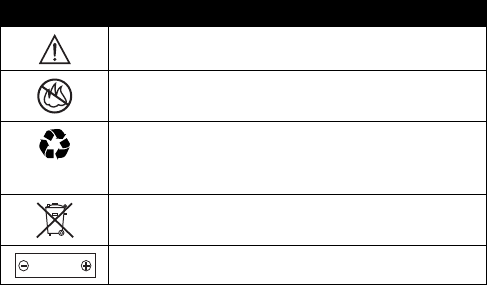
13
PRELIMINARY
Batteries
Batteries can cause property damage and/or bodily injury such as burns if
a conductive material such as jewelry, keys, or beaded chains touch
exposed terminals. The conductive material may complete an electrical
circuit (short circuit) and become quite hot. Exercise care in handling any
charged battery, particularly when placing it inside a pocket, purse, or
other container with metal objects.
Use only Motorola original batteries
and chargers.
Your battery or phone may contain symbols, defined as follows:
Seizures/Blackouts
Some people may be susceptible to epileptic seizures or blackouts when
exposed to flashing lights, such as when watching television or playing
video games. These seizures or blackouts may occur even if a person
never had a previous seizure or blackout.
If you have experienced seizures or blackouts, or if you have a family
history of such occurrences, please consult with your doctor before
playing video games on your phone or enabling a flashing-lights feature
on your phone. (The flashing-light feature is not available on all products.)
Symbol Definition
Important safety information will follow.
Your battery or phone should not be disposed of in a
fire.
Your battery or phone may require recycling in
accordance with local laws. Contact your local
regulatory authorities for more information.
Your battery or phone should not be thrown in the
trash.
Your phone contains an internal lithium ion battery.
LiIon BATT
14
PRELIMINARY
Parents should monitor their children's use of video game or other
features that incorporate flashing lights on the phones. All persons should
discontinue use and consult a doctor if any of the following symptoms
occur: convulsion, eye or muscle twitching, loss of awareness, involuntary
movements, or disorientation.
To limit the likelihood of such symptoms, please take the following safety
precautions:
•
Do not play or use a flashing-lights feature if you are tired or need
sleep.
•
Take a minimum of a 15-minute break hourly.
•
Play in a room in which all lights are on.
•
Play at the farthest distance possible from the screen.
Repetitive Motion Injuries
When you play games on your phone, you may experience occasional
discomfort in your hands, arms, shoulders, neck, or other parts of your
body. Follow these instructions to avoid problems such as tendonitis,
carpal tunnel syndrome, or other musculoskeletal disorders:
•
Take a minimum 15-minute break every hour of game playing.
•
If your hands, wrists, or arms become tired or sore while playing,
stop and rest for several hours before playing again.
•
If you continue to have sore hands, wrists, or arms during or after
play, stop playing and see a doctor.
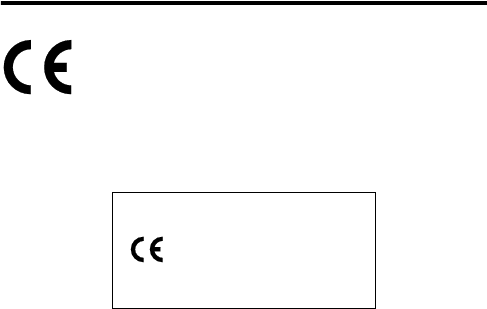
15
PRELIMINARY
European Union Conformance
European Union Directives
Conformance Statement
Hereby, Motorola declares that this product is in compliance
with
•
The essential requirements and other relevant provisions
of Directive 1999/5/EC
•
All other relevant EU Directives
The above gives an example of a typical Product Approval Number.
You can view your product’s Declaration of Conformity (DoC) to Directive
1999/5/EC (to R&TTE Directive) at www.motorola.com/rtte. To find your
DoC, enter the product Approval Number from your product’s label in the
“Search” bar on the web site.
IMEI: 350034/40/394721/9
0168
Type: MC2-41H14

16
Draft
Getting Started
Getting Started
What’s in the Box?
Your multimedia communicator comes with a:
•
Rechargeable battery
•
Rapid charger and regional adapter
•
Desktop charging station
•
Stylus
•
Stereo headset with send/end key
•
CD-ROM with PC sync software, downloadable media
files, utilities, and various applications
•
USB data cable
•
Removable memory card with SD/MMC adapter (see
Note)
•
Protective carrying case (see Note)
•
User documentation
Note:
The in-box items may vary by country. Contact 3 for
more details.
You can customize your communicator for maximum
performance and portability. To buy Motorola Original
™
accessories, contact the Motorola Customer Call Center at
1-800-331-6456 in the United States or 1-800-461-4575 in
Canada.
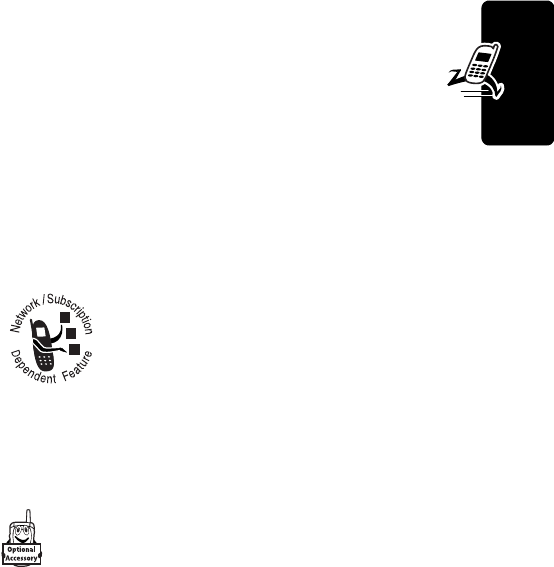
17
Draft
Getting Started
For more information, visit:
www.motorola.com
(United States)
www.motorola.ca
(Canada)
About this Guide
This user’s guide describes the basic features in your
multimedia communicator.
Note:
A
More Here
reference guide for your
communicator is provided on the in-box CD that describes
your communicator’s features in more detail.
Optional Features
Optional Accessories
This label identifies a feature that requires an
optional Motorola Original™ accessory.
Installing the USIM Card
Your USIM (Universal Subscriber Identity Module) card
contains your phone number, service details, and
phonebook/message memory.
This label identifies an optional network,
USIM, or subscriber-dependent feature
that may not be offered by all service
providers in all geographical areas.
Contact your service provider for more
information.
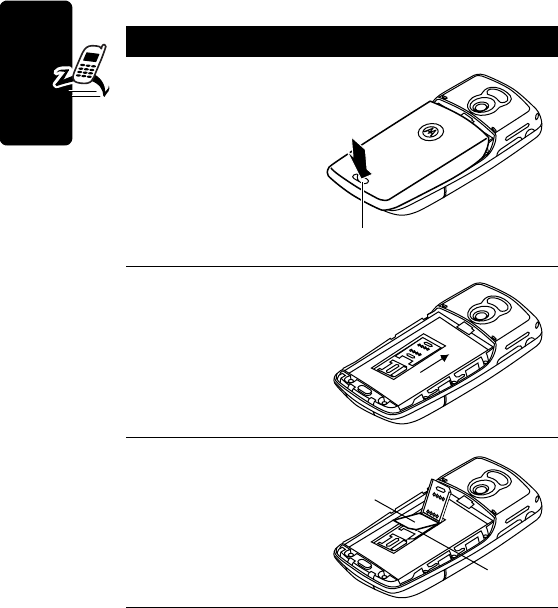
18
Draft
Getting Started
Caution
: Do not bend or scratch your USIM card. Avoid
exposing your USIM to static electricity, water, or dirt.
Action
1
Push down the
release latch,
and slide the
back cover down
to remove it.
2
Slide the USIM
card door toward
the top, then lift
upward to open.
3
Insert the USIM
card into the tray
(gold plated
contacts facing
down, and notch
to the right).
Release Latch
USIM
Card
Notch
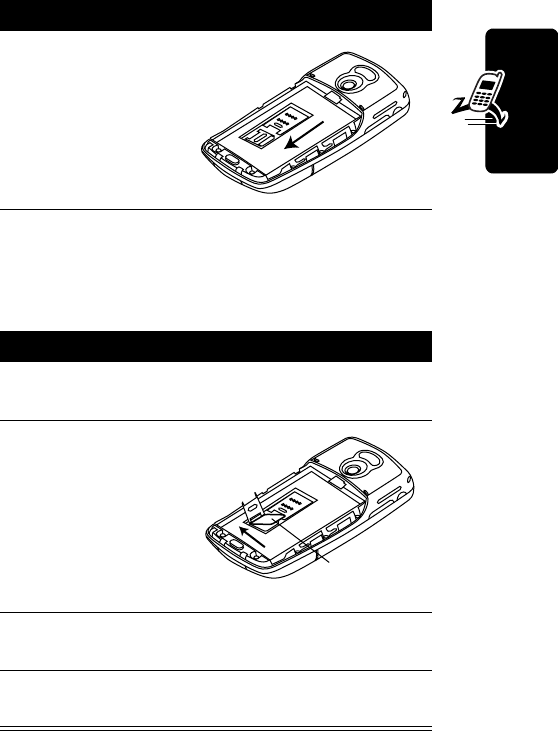
19
Draft
Getting Started
Installing the Memory Card
The memory card lets you an store multimedia files, such
as audio clips, pictures, and video clips.
4
Close the USIM
card door, then
slide downward
to lock, as
shown on the
door and in the
illustration.
Action
1
If back cover is on, remove it as described in the
procedures.
2
Slide the
memory card
door to the left,
as shown in the
illustration, and
lift open.
3
Insert the memory card into the tray (gold plated
contacts facing down, and notches to the right).
4
Close the memory card door, then slide
downward to lock it.
Action
Memory
Card
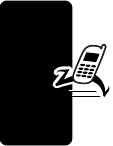
20
Draft
Getting Started
Battery Use
Battery performance depends on many factors including
your wireless carrier’s network configuration; signal
strength; the temperature at which you operate your
phone; the features and/or settings you select and use;
items attached to your phone’s accessory connector
port; your voice, data, and other application usage pattern.
Caution
: To prevent injuries or burns, do not allow metal
objects to contact or short-circuit the battery terminals.
To maximize your battery’s performance:
•
Always use Motorola Original™ batteries and battery
chargers. The phone warranty does not cover damage
caused by using non-Motorola batteries and/or battery
chargers.
•
New batteries or batteries stored for a long time may
require a longer charge time.
•
Maintain the battery at or near room temperature
when charging.
•
Do not expose batteries to temperatures below -10°C
(14°F) or above 45°C (113°F). Always take your
phone with you when you leave your vehicle.
•
When you do not intend to use a battery for a while,
store it uncharged in a cool, dark, dry place, such as a
refrigerator.
•
Batteries gradually wear down and require longer
charging times. This is normal. If you charge your
battery regularly and notice a decrease in talk time or
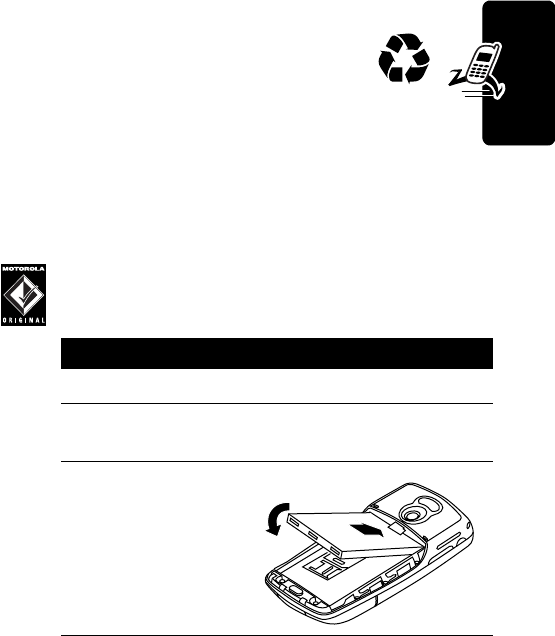
21
Draft
Getting Started
an increase in charging time, then it is probably time
to purchase a new battery.
The rechargeable batteries that power this
phone must be disposed or properly and may
need to be recycled. Refer to your battery’s
label for battery type. Contact your local recycling
center for proper disposal methods.
Warning:
Never dispose of batteries in a fire because they
may explode.
Installing the Battery
Use only Motorola Original™ batteries and
accessories. Store batteries in their protective
cases when not in use.
Action
1
Remove the battery from its plastic bag
2
If the back cover is on, remove it as described in
the procedures.
3
Insert the battery
under the tab
and push down.
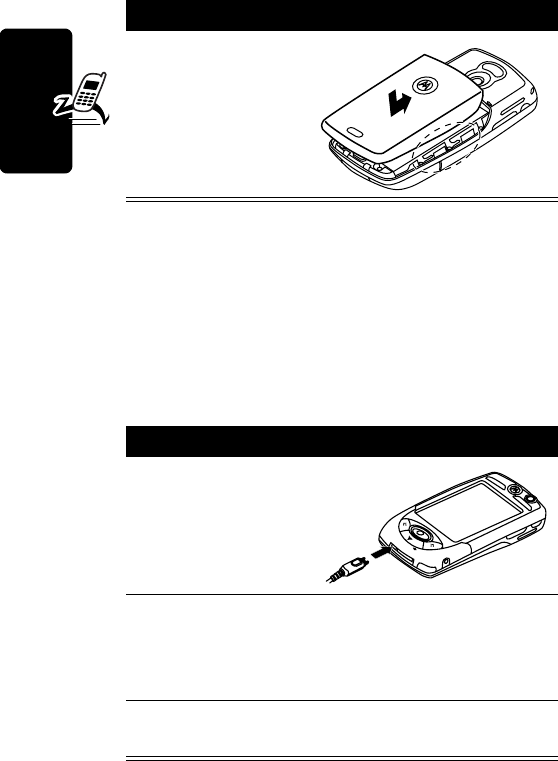
22
Draft
Getting Started
Charging the Battery using the
Travel Charger
New batteries are shipped partially charged. Before you
can use your communicator, you need to install and charge
the battery, as indicated by the following instructions.
Some batteries perform best after several charge/
discharge cycles.
4
Replace back
cover and slide
into place until it
locks.
Action
1
Plug the charger
in with the
release tab up.
2
Plug the other end into an electrical outlet. While
the battery is charging,
Charging Battery
and the
battery’s current charge level (
Very Low
to
High
)
display on the screen.
3
When
Charging Complete
displays, press the
release tab and remove the charger.
Action
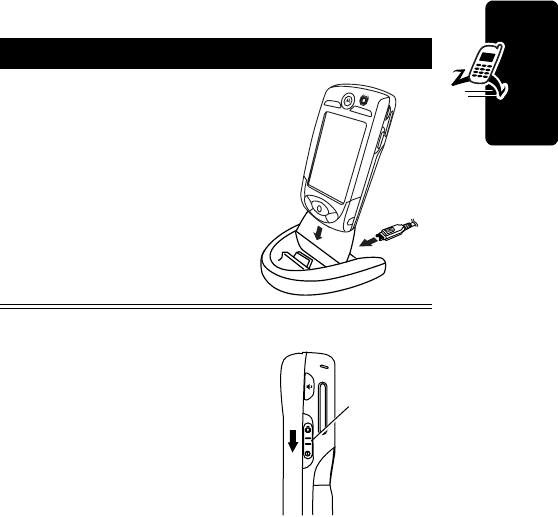
23
Draft
Getting Started
Charging the Battery using the
Desktop Charging Cradle
Turning Your
Communicator On
and Off
After you turn the communicator
on, your personal home page
displays after the startup
sequence (see page 38).
Action
1
Plug the travel charger,
release tab end, into the
back of the charging
cradle with the release
tab up.
2
Plug the other end into
an electrical outlet.
Slide switch
down for 1
second to turn
on or off.
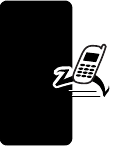
24
Draft
Getting Started
Setting Up Your Communicator for
the First Time
When you turn on the communicator for the first time,
you need to:
•
Install the A1000 Desktop Suite from the in-box
CD. See page 72 for set up and installation
procedures.
•
Select primary and secondary languages
•
Calibrate the screen for accurate screen taps (see
page 67).
•
Set time and date (see page 88).
Making and Answering Calls
To make and answer calls, your communicator must:
•
be turned on
•
have a USIM card installed
•
have a network connection with adequate signal
strength
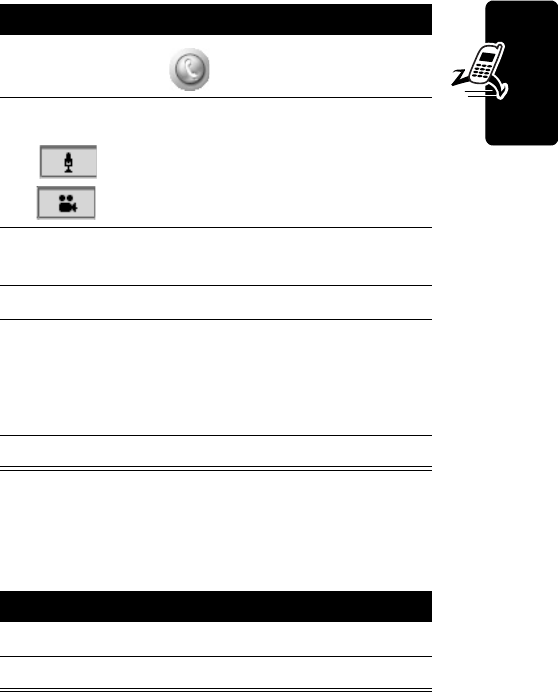
25
Draft
Getting Started
Making a Call
Answering a Call
When you receive a call, the communicator rings or
vibrates (unless set to Silent mode).
Action
1
Press
A
or tap .
2
Select a voice or video call by tapping:
voice call
video call
3
Use the stylus to tap the number you want to dial
on the keypad.
4
Press
B
.
5
Press
a
to turn on the speakerphone during
the call (see page 42).
Note:
You must be in an active call to use the
speakerphone.
6
To end the call, press
A
.
Action
1
Press
B
or tap
Answer
.
2
To end the call, press
A
.
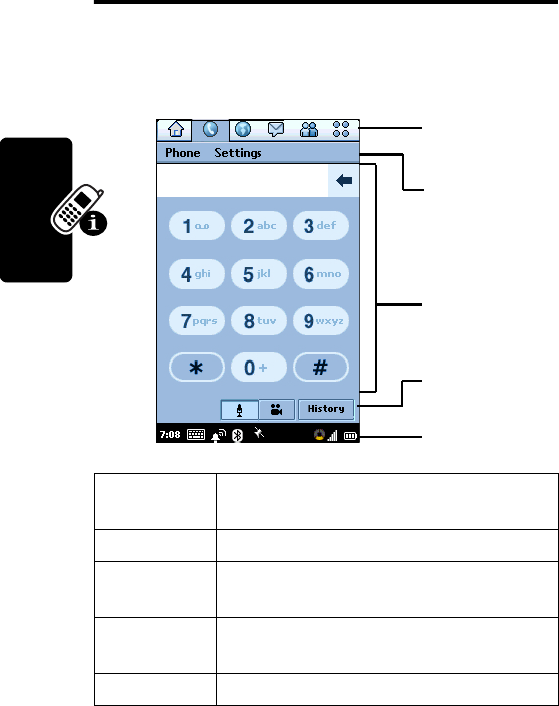
26
Draft
Using Your Communicator
Using Your Communicator
See page 1 for a basic phone diagram.
Communicator Display
Application
Selector Bar
Shows six icons that allow easy to
access to commonly used applications.
Menu Bar
Shows menus for the open application.
Application
Space
Shows the open application.
Button Bar
Shows buttons you can select in the
open application.
Status Bar
Shows communicator status information.
Application
Space
Application
Selector Bar
Menu Bar
Button Bar
Status Bar
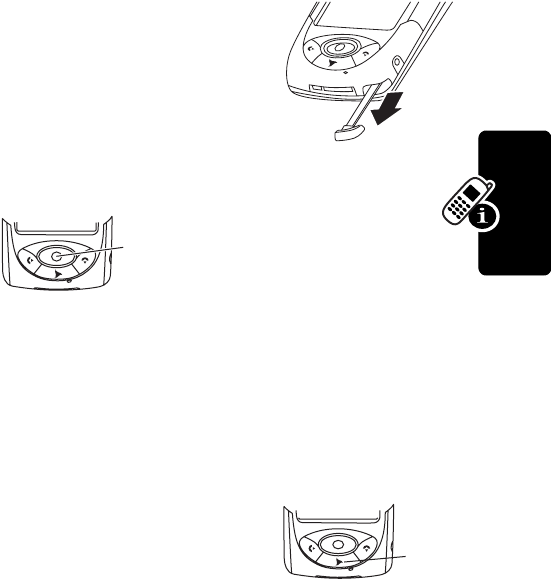
27
Draft
Using Your Communicator
Using Touchscreen Control
The stylus fits in a compartment
on the side of the communicator.
Using the stylus, tap once on an
icon, text, or on-screen button to
select and open an item.
Using the 8-way
Navigation Key
Yo u c an press the
navigation key up, down,
left, or right to highlight an
item. Press the center key to
select the highlighted item.
Note:
This guide describes how to use touchscreen
control to use the features. In most cases, it does not
include the equivalent 8-way Navigation key for using the
feature.
Using the 3 Key
The 3 key (
E
) provides access
to unique features from 3. See the
3 welcome package for more
details.
•
Press to open the browser.
•
Press and hold for 3 seconds to go to
My Shortcut
.
Note:
The default shortcut is Home. To change the
shortcut, see page 68.
Navigation
Key
3 Key
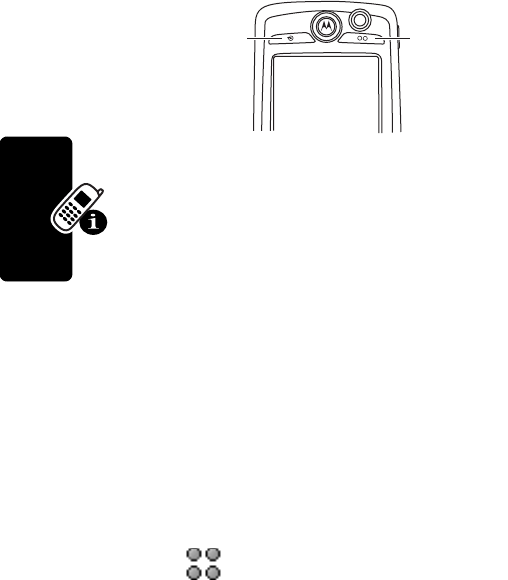
28
Draft
Using Your Communicator
Using the Game Keys
Game Key A and Game Key B
These keys are used when you play games on your
communication. The action of each key varies
depending on the game being played.
Tip:
You can press Game Key A (
A
) to open the first
(leftmost) menu in the menu bar. Press
A
again to close
the menu.
Opening Applications
Your communicator has many built-in applications for
communications, personal organization, and
entertainment. Each application has an associated icon.
You can open an application in the following ways:
•
Select an icon in the Application Selector bar.
•
Select . The Application Launcher displays,
showing icons of all of your communicator’s
applications. Select the application you want to open.
Note:
You don’t have to save and close an application
before going to another. Changes or entries in the opened
application are automatically saved.
Game Key A Game Key B
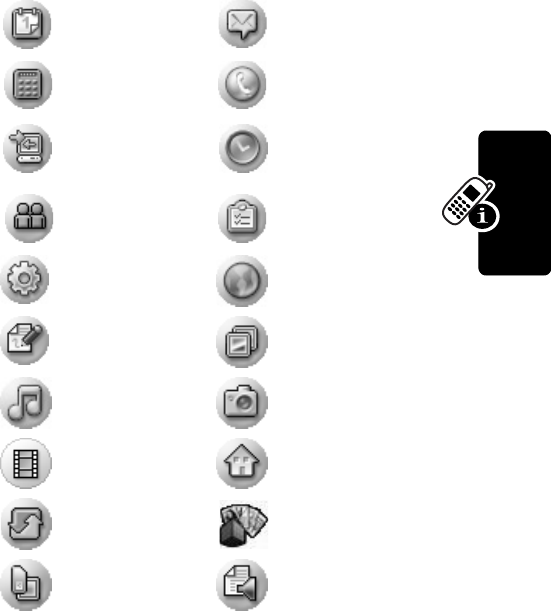
29
Draft
Using Your Communicator
The following icons open the communicator applications:
Calendar
(see page 81)
Messaging
(see page 50)
Calculator
(see page 81)
Phone
(see page 41)
Desktop Suite
(see page 74)
Time
(see page 88)
Contacts
(see page 58)
To d o
(see page 84)
Control Panel
(see page 66)
Browse
(see page 97)
Notes
(see page 88)
Pictures
(see page 116)
Music
(see page 100)
Camera
(see page 107)
Video
(see page 112)
Home
(see page 38)
SyncML
(see page 75)
Picsel Viewer
(see page 100)
SimApps
(see page 120)
Voice
(see page 92)
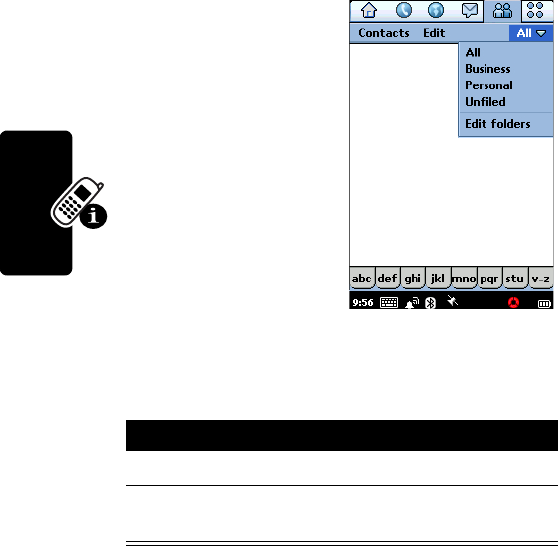
30
Draft
Using Your Communicator
Folders
Many applications include a
group of folders. The current
folder name appears on the
right side of the menu bar at
the top of the screen.
You can use folders to
organize your entries. For
example, you can create
separate folders for
business and personal
entries.
Switching Folders
Tap the current folder name, then select a folder from the
list. To view every entry in every folder, select
All
.
Filing New Entry in Folder
Action
1
In the application, select a folder.
2
Create a new entry. The entry is automatically
assigned to the folder.
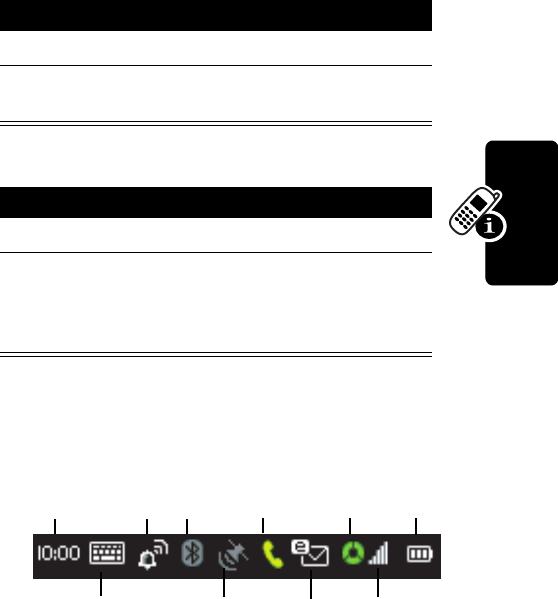
31
Draft
Using Your Communicator
Moving Entry to a Different Folder
Adding, Renaming, and Deleting Folders
Status Indicators
The status bar at the bottom display the following status
indicators:
Clock –
Shows the current time. Tap clock to briefly
display the date.
Action
1
Open the entry.
2
Select a different folder. The entry is moved to
the folder.
Action
1
Tap the current folder, then select
Edit folders
.
2
To add a new folder, tap
Add
.
To rename a folder, tap
Rename
.
To remove a folder, tap
Delete
.
Keyboard
Launcher
Phone
Clock
Alert
Mode
Location
Mode Message
Battery
Strength
Signal
Strength
Network
Bluetooth
Status
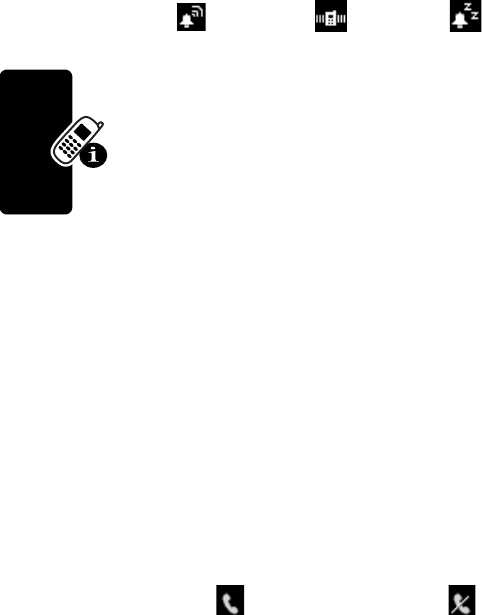
32
Draft
Using Your Communicator
Keyboard Launcher –
Tap to display the on-screen
keyboard. (The keyboard displays only when the cursor is
in a text-entry field.)
Alert Mode –
Shows the current alert mode:
Audio: Vibrate: Silent:
The alert mode indicates how the communicator notifies
you of an incoming call or message.
To change the alert mode, tap the indicator, then select
a new setting.
Bluetooth Status –
Shows the current Bluetooth
status:
On: White Off: Gray
Tip:
You can tap the icon, then select to turn on or turn off
Bluetooth (see page 72).
Location Mode –
Shows if the GPS (Global Positioning
System) Location service is off, idle (in standby), or busy
(requesting location information). The color indicates the
Location mode:
Off: Gray Idle: White Busy: Green
To turn the Location service on or off, tap the indicator,
then select the setting you want. The Location service
allows you to track your current location on the
communicator screen.
Phone –
Shows the status of an active call:
Connected: Muted:
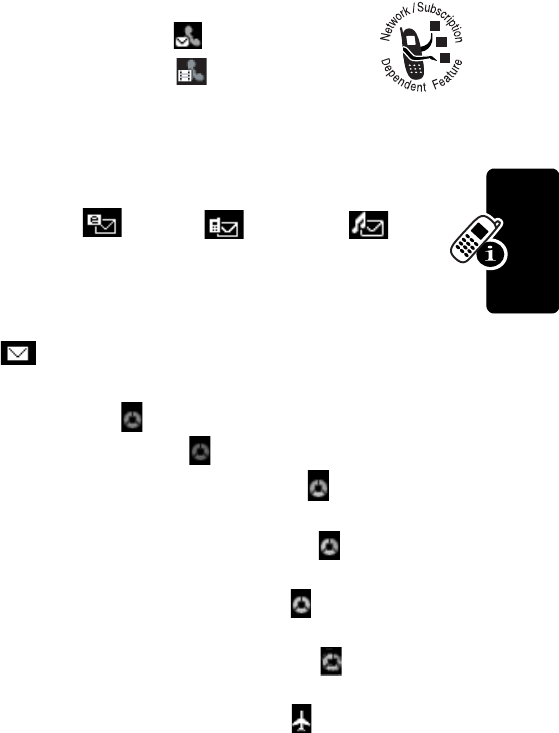
33
Draft
Using Your Communicator
When not in an active call:
Voicemail waiting:
Videomail waiting:
Note:
Videomail may not be offered by all
service providers in all geographical areas.
Message –
Shows that you have a new message and the
type of message:
Email: SMS: MMS:
If an MMS or SMS message sender’s phone number is
in your Contact list, the indicator is white. If the sender’s
phone number is not in your Contact list, the indicator is
amber. If multiple types of new messages are available,
displays.
Network –
Shows the type of network service connection:
No service: (gray)
Emergency service: (red)
Connected to GSM home network: (one green
segment)
Connected to GPRS home network: (two green
segments)
Connected to 3G home network: (three green
segments)
Roaming to non-home type network: (three amber
segments)
Airplane mode (phone disabled):
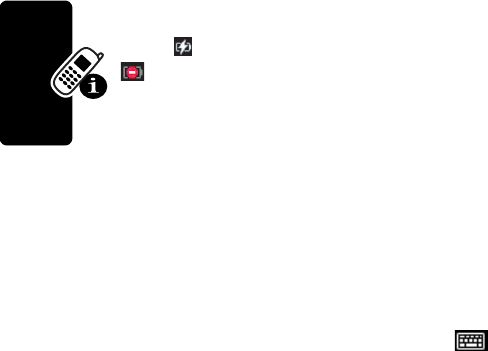
34
Draft
Using Your Communicator
To turn Airplane mode on or off, tap the indicator, then
select the setting you want (see page 49).
Signal Strength –
Shows the network signal strength. The
more bars, the stronger the network signal.
Battery Strength –
Shows the amount of charge in your
battery. The more bars, the greater the charge. The
indicator is amber when the communicator is using a large
amount of battery power, such as during a video call.
When displays, the battery is charging, and when
displays, the battery cannot receive a charge.
Entering Text
Two text entry methods make it easy to enter names,
numbers, and text messages on your communicator.
Handwriting Recognition
Note:
You can use the handwriting pad only when the
screen cursor is in a field that allows you to enter text.
You can use the stylus as a pen to write letters, numbers,
and punctuation. To write with the stylus, tap in the
status bar. The handwriting pad or the keyboard displays
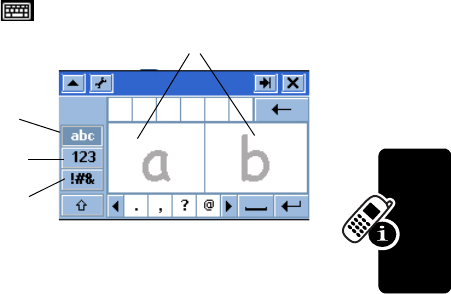
35
Draft
Using Your Communicator
(depending on which you used last). If the keyboard
displays, tap , then tap
Handwriting
in the popup menu.
To write, tap the letter, number, or characters button on the
left side of the handwriting pad. Then use the stylus to
write in one of the two writing spaces. For best
performance, alternate between the writing spaces so
recognition can occur in one while you write in the other.
To enter punctuation marks, special characters, spaces,
and returns, tap the buttons beneath the writing spaces.
Writing spaces
Tap to w r ite
letters
Tap to w r i t e
numbers
Tap to w r i t e
special
characters
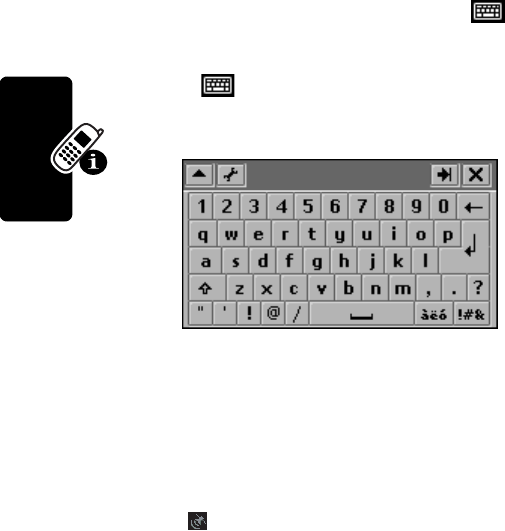
36
Draft
Using Your Communicator
Virtual Keyboard
Note:
You can use the keyboard only when the screen
cursor is in a field that allows you to enter text.
To use the on-screen keyboard to type text, tap in the
status bar. The handwriting pad or the keyboard displays
(depending on which you used last). If the handwriting pad
displays, tap again, then tap
Roman Keyboard
in the
popup menu.
To type, tap the keyboard keys with the stylus.
Using AGPS Location Information
Your communicator can use Assisted Global Positioning
Service (AGPS) to tell the network where you are
physically located.
To change your Location Mode setting, tap the Location
Mode icon ( ) in your communicator’s status bar
(page 32).
Limitations of AGPS
Sometimes adequate signals from multiple satellites are
unavailable, usually because your AGPS phone’s antenna
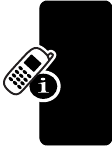
37
Draft
Using Your Communicator
cannot establish a view of a wide area of open sky. In
these cases, the AGPS feature
will not work
. Such
situations include, but are not limited to, the following:
•
in underground locations
•
inside of buildings, trains, or other covered vehicles
•
under any other metal or concrete roof or structure
•
between tall buildings or under dense tree cover
•
near a powerful radio or television tower
•
when your AGPS antenna is covered (for example,
by your hand or other object) or facing the ground
•
when there are temperature extremes outside the
operating limits of the phone
Even where location information can be calculated in such
situations, it may take more time than usual, and your
location estimate may not be as accurate. Walking or
driving very slowly may also substantially reduce AGPS
performance.
Even where adequate signals from multiple satellites are
available, your AGPS feature will provide only an
approximate location, often within 150 feet (45 meters) but
sometimes much farther from your actual location.
The satellites used by your phone's AGPS feature are
controlled by the U.S. government and are subject to
changes implemented in accordance with the Department
of Defense AGPS user policy and the Federal Radio
Navigation Plan. These changes may affect the
performance of your phone's AGPS feature.
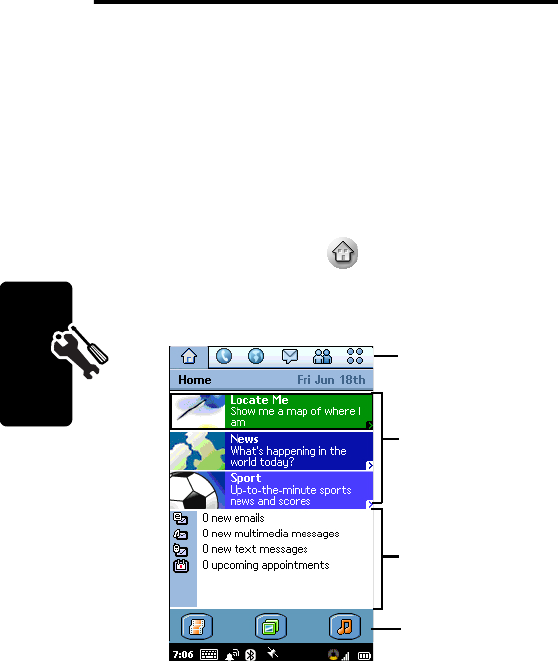
38
Draft
Home Screen
Home Screen
The Home screen shows a variety of content. This could
be a summary of your appointments, messages, and
personal links to content such as news, entertainment, and
sports.
Displaying the Home Screen
The Home screen displays after the startup sequence
when you turn on the communicator. You can also display
the Home screen by tapping in the Application
Selector bar.
Screen Contents
Information
Snacks
Personal
Information
Application
Shortcuts
Application
Selector Bar
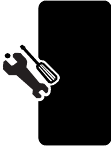
39
Draft
Home Screen
Information Snacks
– Shows the three most recently
received information snacks (headlines). Tap a snack to go
to a Web page with more information.
Note:
See the 3 welcome package for information about
information snacks.
Personal Information
– Shows information you want
displayed in your Personal Information section. Depending
on the items you select, this section shows the number of
new voicemail, messages, appointments, and active tasks
you have.
Application Shortcuts
– Shows 3 icons for fast access to
your favorite applications.
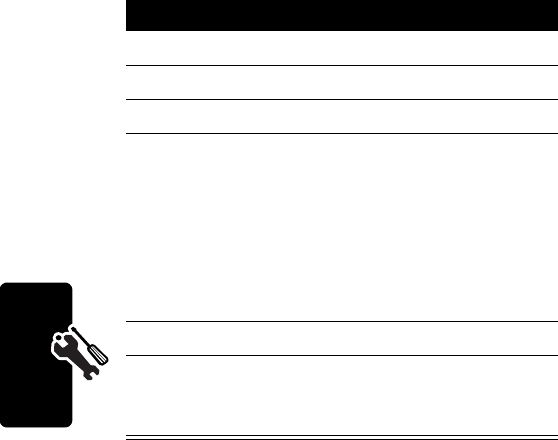
40
Draft
Home Screen
Personalizing Home Screen
Note:
To receive updated information from 3, tap
Contents
tab, then tap
Update
. Refer to the 3 package for more
details.
Action
1
Go to the Home screen (if not already shown).
2
Tap
Home
>
Preferences
.
3
Tap
Events
tab.
4
Select up to six items you want displayed in the
Personal Information section by tapping the
appropriate checkbox.
Note:
When six items are already selected, the
other items are no longer selectable. To change
or add a selection, you must remove the
checkmark from a currently selected item.
5
Tap
Applications
tab.
6
Select the three applications you want displayed
in the Applications Shortcuts section, then tap
Done
.
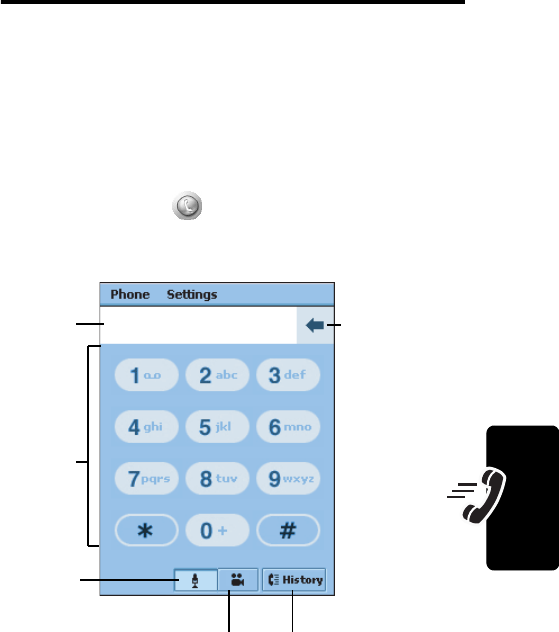
41
Draft
Calling Features
Calling Features
Opening Phone Application
Use the Phone application to make voice and video phone
calls. You can open this application in the following ways:
•
Press
B
. When the Phone application opens, a list of
the most recently dialed calls displays.
•
Press
A
or tap in the Application Selector bar
or Application Launcher. When the Phone application
opens, the dialing keypad displays:
Tap keys
to dial
number
Tap to
erase last
digit
Display
Tap to
place
voice call
Tap to switch between
keypad and call list
Tap to place video
call
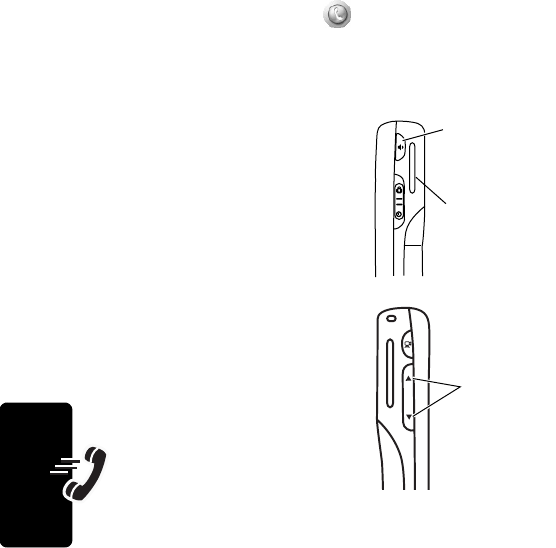
42
Draft
Calling Features
Displaying Your Phone Number
Your phone number must be programmed on your USIM
card to use this feature. Tap in the Application
Selector bar. Tap
Phone
>
My line(s)
. The communicator
shows your phone number(s).
Using the Internal
Speakerphone
To turn on the internal
speakerphone during an
incoming or active call,
press
a
.
Adjusting the
Volume
Press the top of the volume key
to increase volume or the
bottom of the key to decrease
volume for the earpiece,
speakerphone, or headset
during a call.
Speakerphone
Key
Speakerphone
Port
Volume
Keys
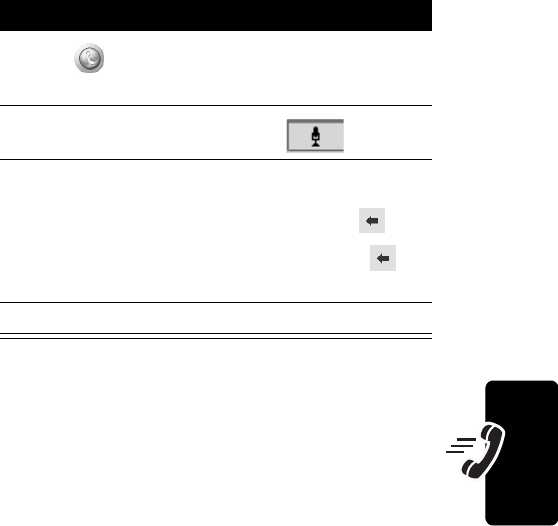
43
Draft
Calling Features
Making a Voice Call
Dialing with the Keypad
Dialing Stored Phone Numbers
You can automatically dial stored phone numbers (see
page 58)
Redialing Failed Voice Calls
If a voice call fails (busy or not answered),
Call Failed
displays. To redial the call, tap the
Retry
button.
Making a Video Call
You can make video calls to other devices that have video
call capabilities.
Action
1
Tap in the Application Selector bar or
Application Launcher.
2
Select a voice call by tapping ( )
3
Tap the phone number on keypad.
4
If you make a mistake while dialing, tap to
delete the last digit entered. Tap and hold to
delete multiple or all digits.
5
Press
B
to make the call.
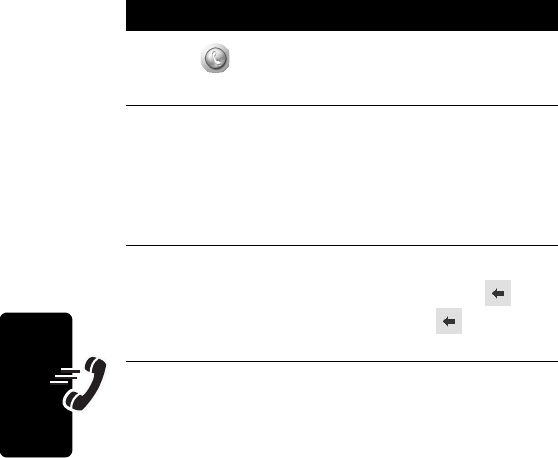
44
Draft
Calling Features
Making a Video Call to Another Phone
You can make a video call to another phone by dialing the
phone number on the keypad.
Shortcut:
You can automatically place video calls to
stored phone numbers.
Action
1
Tap in the Application Selector bar or
Application Launcher.
2
Position the front camera lens or P2P (point-to-
point) lens so that it faces the image you want to
send, (see page 108.)
Note:
The speakerphone automatically turns on
during a video call.
3
Tap the phone number on keypad.
If you make a mistake while dialing, tap to
delete the last digit. Tap and hold to delete
multiple or all displayed digits.
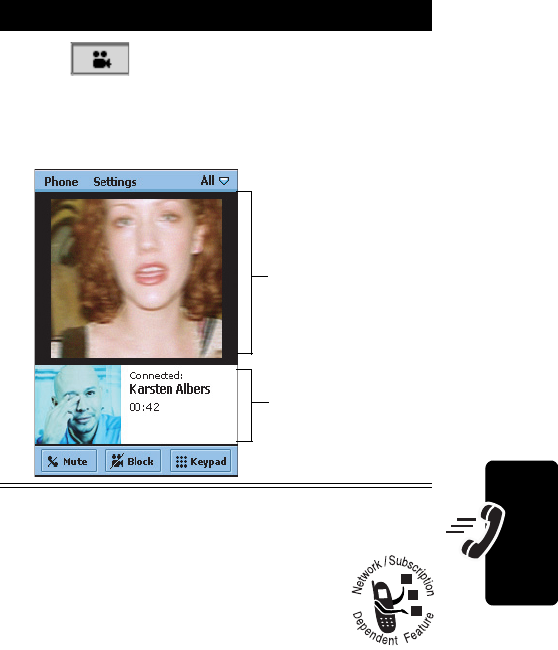
45
Draft
Calling Features
Making a Video Call to a Computer
To make a video call to a computer, you
can use:
• Call History List
– To call a computer
in your call history list, tap the email
address you want to call.
• Contacts
– To call stored phone numbers, see
page 58.
4
Ta p .
When the call connects, the screen shows the
remote camera image on top and the local image
on the bottom.
Action
Remote image
Local image
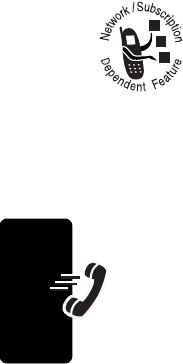
46
Draft
Calling Features
• Embedded email address
– To call a computer’s
email address, tap the address in an email, SMS,
MMS, or text message, or an HTML page.
Calling an Emergency Number
Your service provider may program one or more
emergency phone numbers, such as 911 or 112, that you
can call under any circumstances, even when your
communicator is locked or the USIM card is not inserted.
Your service provider can program additional
emergency numbers into your USIM card.
However, your USIM card must be inserted in
your phone in order to use the numbers
stored on it. See your service provider for
additional information on this issue.
Note:
Emergency numbers vary by country. Your
communicator’s preprogrammed emergency number(s)
may not work in all locations, and sometimes an
emergency call cannot be placed due to network,
environmental, or interference
issues.
Using AGPS During an Emergency Call
When you make an emergency call, your phone's
assisted-Global Positioning System (AGPS) feature can
calculate your approximate location and help emergency
service personnel find you.
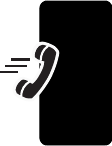
47
Draft
Calling Features
Notes:
•
This feature can work only if the emergency response
center can receive and process location information. If
you are concerned about whether your local
emergency response center can receive AGPS
location information, contact your local authorities.
•
In order for the AGPS feature to work when making
emergency calls, the service must be turned on (see
page 32).
For best results, you should be located where your phone’s
antenna can establish a clear view of the open sky. This
allows your phone to access AGPS satellite signals. Even
under good conditions, it may take 30 seconds or more to
determine your approximate location. This time increases
and the accuracy of the results decreases with reduced
access to satellite signals.
If your communicator does not have access to AGPS
satellite signals, the location of the nearest cell tower in
contact with your phone is automatically provided to the
emergency response center.
Because of the limitations of the AGPS feature, always
provide your best knowledge of your location to the
emergency response center, just as you would when using
a phone without AGPS capabilities. Also, remain on the
phone for as long as the emergency response center
instructs you.
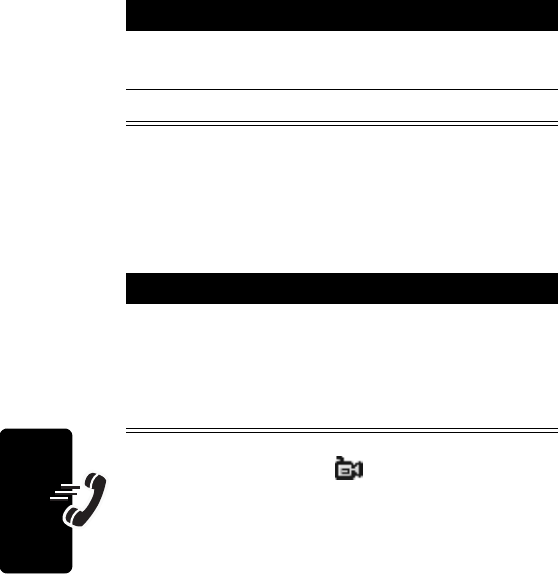
48
Draft
Calling Features
Dialing the Call
Answering Calls
When you receive an incoming voice or video call, the
communicator rings or vibrates (unless set to Silent
mode).
Notes:
Video calls display to the left of the call.
Action
1
Press keypad keys to dial the emergency
number.
2
Press
B
to call the emergency number.
Action
Press
B
or tap
Answer
to answer the call.
Note:
Press
a
to turn on the speakerphone.
If you do not want to accept the call, press
A
or tap
Busy
.
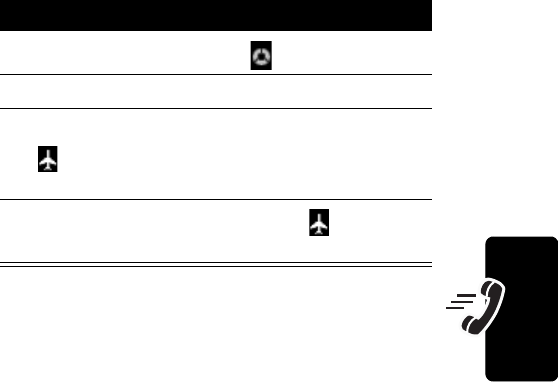
49
Draft
Calling Features
Switching to Airplane Mode
If you want to use the commuicator’s personal organization
and entertainment features in a situation where telephone
use is not allowed (such as on a plane), switch the
communicator to Airplane mode.
In Airplane mode, you cannot connect to the network to
make phone calls or send messages. Also, Bluetooth and
GPS Location service are not available.
Turning off Call Ringing
You can turn off ringing for incoming calls by setting the
communicator’s alert mode to vibrate or silent (see
page 32).
Action
1
Tap the Network indicator ( ) in the Status bar.
2
In the Connection Mode box, tap
Aeroplane Mode
.
3
Ta p
Done
.
displays when the communicator is in
Airplane mode.
4
To return to normal operation, tap , then tap
Handset On
.

50
Draft
Messages and Email
Messages and Email
You can create, send, and receive email, MMS (Multimedia
Message Service), and SMS (Short Message Service)
messages.
To send stored audio, video, and picture files with your
email and MMS messages. See the “News and
Entertainment” beginning on page 97.
Setting up Messaging Accounts
Before you can send and receive messages,
you must set up your accounts. Contact your
service provider for account details.
Email
To send and receive email, you must set up an Internet
account and an email account
The communicator supports IMAP4, POP3, and SMTP
protocols.
To create an Internet account:
Action
1
Open Control Panel application ( ).
2
Tap
Connections
tab >
Internet accounts
>
Accounts
tab.
3
Tap
New
.
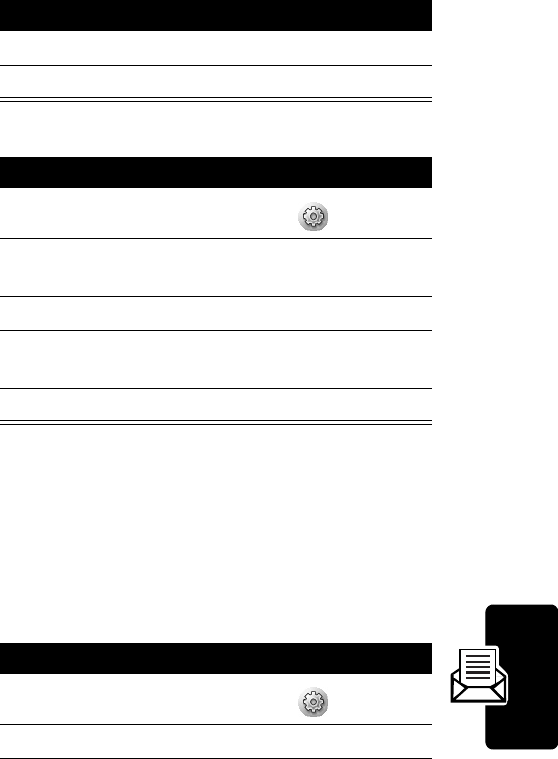
51
Draft
Messages and Email
To create an email account:
Note:
See the A1000
More Here
reference guide on the
in-box CD for more information.
MMS and SMS
Your service provider should already have set up MMS and
SMS (text messages) accounts on your communicator.
To check account settings:
4
Enter information about your account.
5
Ta p
Done
.
Action
1
Open Control Panel application ( ).
2
Ta p
Connections
tab >
Messaging accounts
>
Email
tab.
3
Ta p
New
.
4
Enter information about your account on the
Basic
,
Inbox
,
Outbox
, and
Advanced
tabs.
5
Ta p
Done
.
Action
1
Open Control Panel application ( ).
2
Ta p
Connections
tab >
Messaging accounts
.
Action
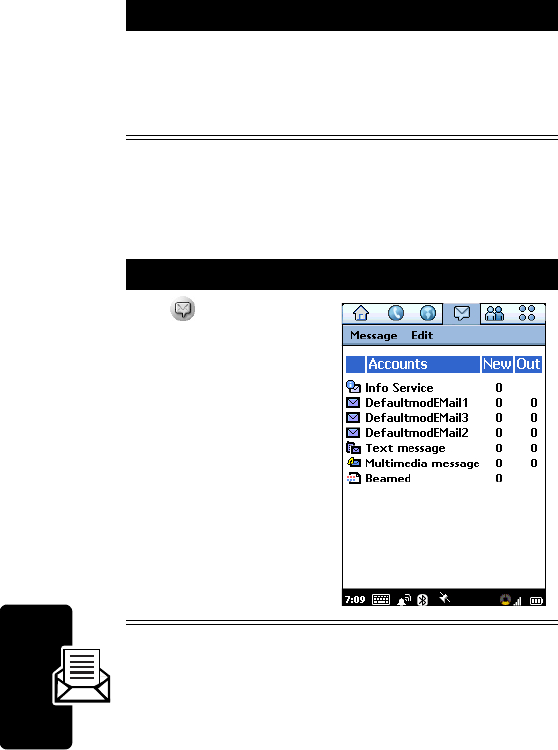
52
Draft
Messages and Email
Opening Messaging Application
Use the Messaging application to create, send, and
receive messages.
3
Tap the
Email
,
Text message
,
Multimedia message
, or
Info Service
tabs to view account settings. Tap the
left and right arrows to move between the
account tabs.
Action
Tap in the
Application Selector bar
or Application
Launcher. When the
Messaging application
opens, it shows a list of
your established
accounts.
Note:
The account
stores data received
using Bluetooth (see
page 72).
Action
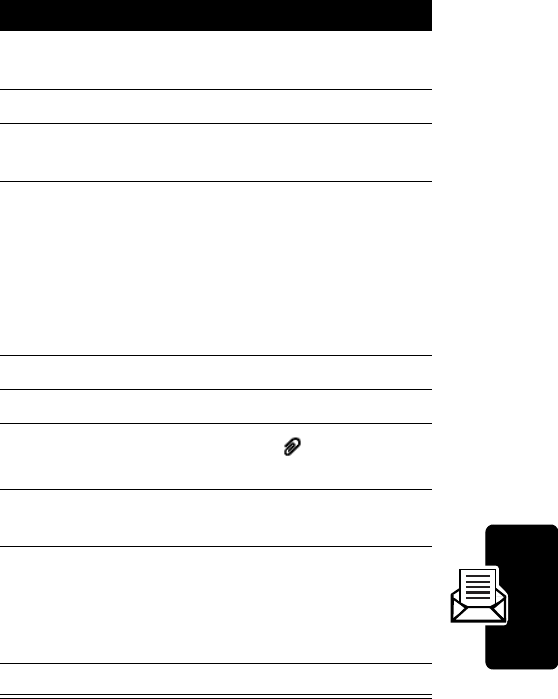
53
Draft
Messages and Email
Creating and Sending Messages
Email and SMS
Action
1
Tap the email or SMS account in the list of
accounts.
2
Ta p
Message
>
New
.
3
Ta p
Text only
,
Media only
, or
Text & media
, then tap
Done
.
4
In the
To
field, enter the recipient’s address
(email) or phone number (SMS).
To enter a stored address or phone number from
Contacts, tap
To
.
To enter several addresses or phone numbers,
enter a comma between each.
5
In the
Subj
field (email only), write a subject line.
6
In the text area, write the text message.
7
To add an attachment, tap the tab, then tap
Add
.
8
In the
Type
field, select the file type you want to
attach, then tap
Done
.
9
Tap the stored file you want to attach, then tap
Add
.
Note:
You cannot send or forward media files
that are forward-locked.
10
When message is complete, tap
Send
.
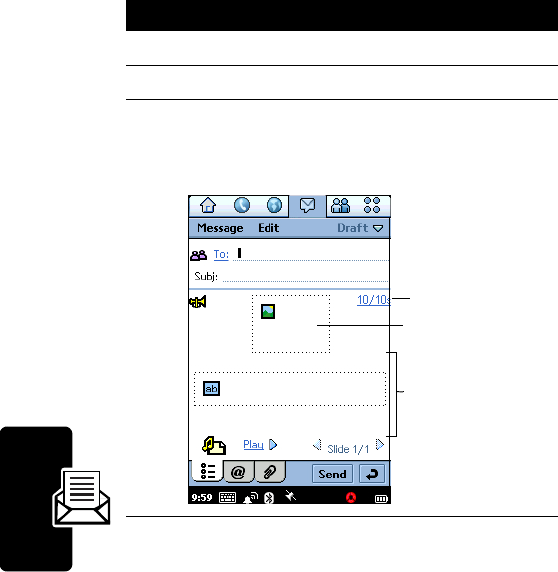
54
Draft
Messages and Email
Note:
If you accept a video call while composing an email
or SMS message, the message is automatically saved to
either the email or SMS draft folder.
MMS
You can create and send MMS messages that contain one
or more slides with audio, video, images, and documents.
Action
1
Tap the MMS account in the list of accounts.
2
Tap
Message
>
New
.
3
Tap
Text only
,
Media only
, or
Text & media
, then tap
Done
.
The first slide of the message displays:
Image area
Text area
Duration label
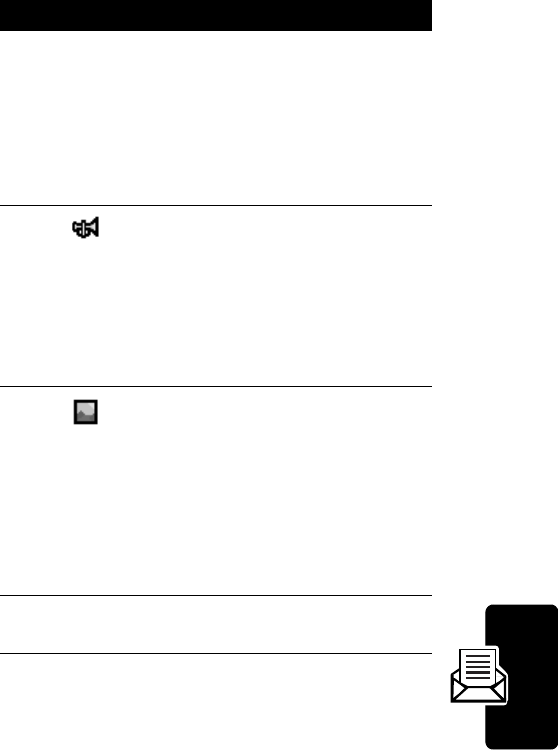
55
Draft
Messages and Email
4
In the
To
field, enter the recipient’s phone number
or email address. (The recipient must also
subscribe to MMS messaging.)
To enter a stored number from
Contacts
, tap
To
.
To enter several phone numbers, enter a comma
between each.
5
Tap to add a sound. You can then record a
new sound or select a stored audio file.
You can add WAV and AMR audio files to an
MMS message.
Note:
You cannot send or forward media files
that are forward-locked.
6
Tap to add an image, then select a stored
image file.
You can add the following types of stored image
files to an MMS message: BMP, WBMP, GIF,
PNG, JPEG, and TIFF.
Note:
You cannot send or forward media files
that are forward-locked.
7
Tap the text area to place a cursor in the text
area. Enter text with stylus or virtual keyboard.
Action
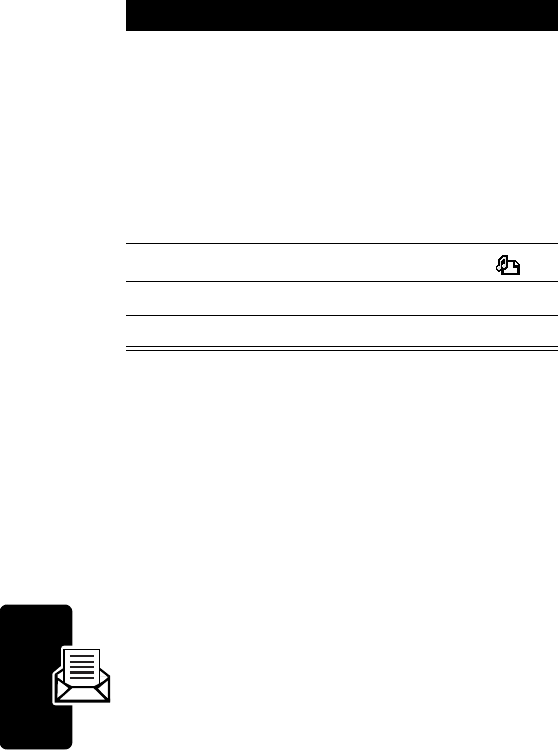
56
Draft
Messages and Email
Notes:
•
The maximum file size of an MMS message is 30 KB.
If you exceed this size, a warning message displays.
Remove audio or video files to reduce the file size.
•
If you accept a video call while composing and email
or SMS message, the message is automatically saved
to either the email or SMS draft folder.
8
To set the slide duration, tap the duration label
(
10/10s
). Specify how long (in seconds) you want
the slide to play before automatically advancing
to the next slide in the message.
The first number in the duration label indicates
the duration of the current slide. The second
number indicates the total duration of all slides in
the message.
9
To add another slide to the message, tap .
10
To play the slide presentation, tap
Play
.
11
When message completes, tap
Send
.
Action
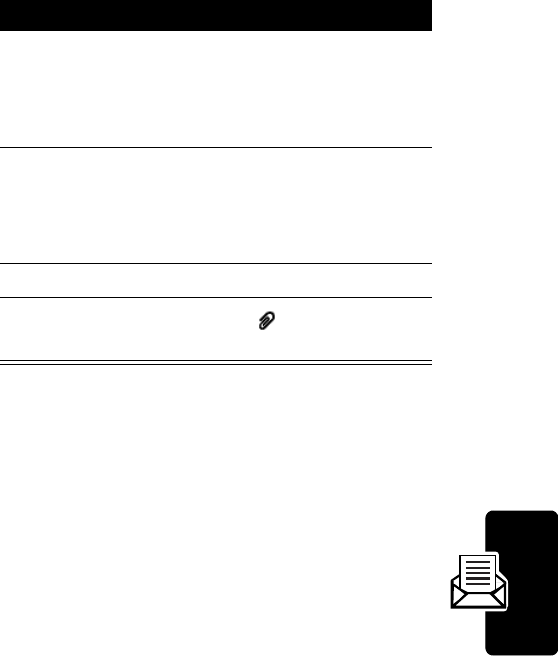
57
Draft
Messages and Email
Receiving and Reading Messages
When a new message is received, a message indicator
displays in the status bar (see page 31).
Action
1
Tap the message indicator in
Status
bar.
The Messaging application opens, showing a list
of established accounts. The number of unread
messages displays next to each account.
2
Tap the account containing the message you
want to read.
A list of messages displays. Unread messages
display in bold.
3
Tap the message you want to read.
4
Attachments display with a . Tap the
attachment to open it.
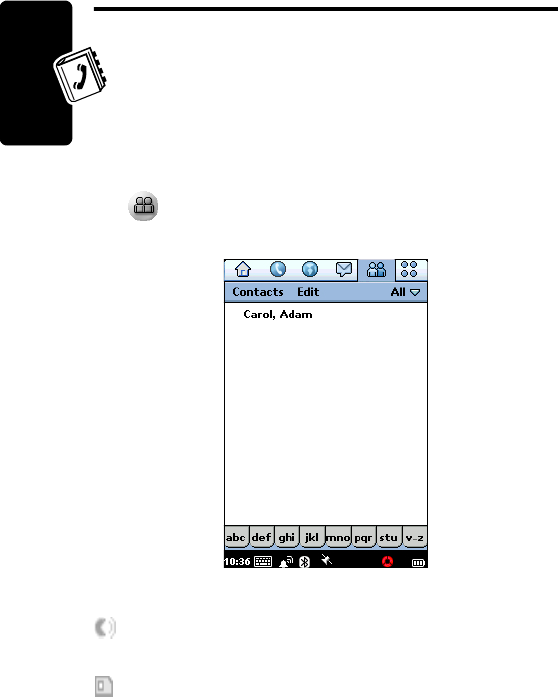
Draft
58
Contact List
Contact List
Use the Contacts application to store details such as
names, phone numbers, and email addresses in an
alphabetical list of entries. You can call or send a
message to any stored contact from this list.
Opening Contacts Application
Tap in the Application Selector bar or Application
Launcher. An alphabetical list of stored contacts displays:
The following icons can display next to a contact name:
– Displays if contact has a voice tag assigned to a
phone number (see page 62).
– Displays if contact is saved in the USIM folder.
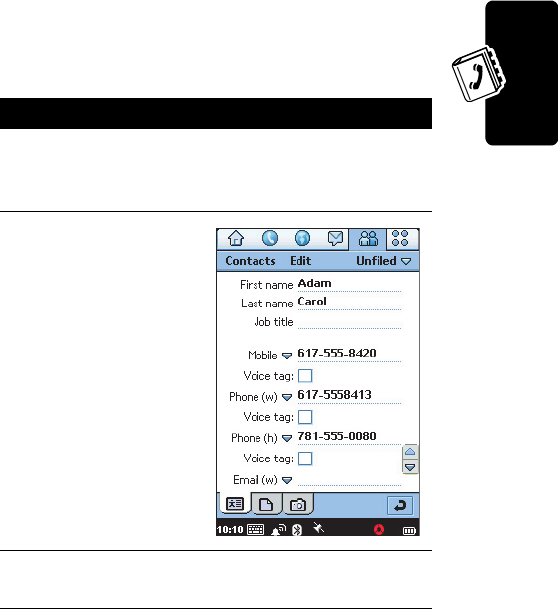
Draft
59
Contact List
To see each contact’s preferred phone number next to their
name, tap
Edit
>
Preferences,
then tap the
Show preferred
phone number
tab.
Adding Contacts
Action
1
Open the folder in which you want to save the
contact. To store the contact on your USIM card,
open the USIM folder.
2
Ta p
Contacts
>
New
to display the
Contact information
form.
3
Enter contact name, phone numbers, email
address, and other information.
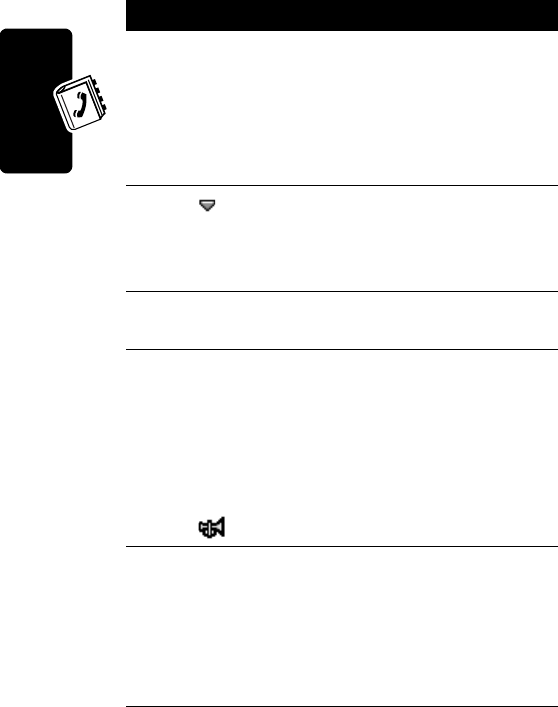
Draft
60
Contact List
Note:
If you enter more than one phone number,
(for example, a work and home number), you can
select which number displays in the contact list
as the preferred phone number. To do so, tap
Edit
>
Preferred number,
then
select the desired
preferred phone number from the list.
4
Tap preceding each phone number to select
its communication method: Phone (land line),
Mobile, Email, Web, or Web call (email address
for 2-stage dialing video call).
5
To record a voice tag, refer to “Recording Voice
Tags for Contacts” on page 62.
6
To assign a unique ring tone to the contact, tap
the down arrow, if necessary, then tap the
Ring
tone
box.
7
Select a tone from the list. When you receive a
voice or video call from this contact, the selected
ring tone plays.
8
Tap to play the selected ring tone.
9
To add a new field to the contact, tap
Edit
>
Add
Field
. “Adding New Fields” on page 61.
Note:
This step is optional. However, the fields
must be added when entering the contact
information. You can not add new fields after you
save the contact.
Action
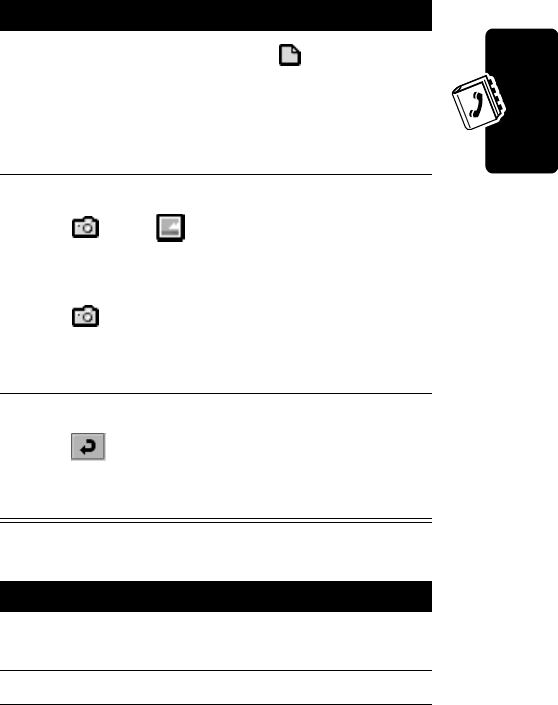
Draft
61
Contact List
Adding New Fields
10
To add a note to a contact, tap , then enter the
note.
11
You can mark a note as Private. Private notes
are not included when you send or synchronize
contact details.
12
To assign a stored photo or image to the contact,
tap , then , then select the photo or
image.
or
tap to take a photo
The contact’s assigned image displays when you
make a call to or receive a call from the contact.
13
When you have entered all contact information,
tap .
The contact now displays in the alphabetical list
of contact names.
Action
1
When entering information for a new contact, tap
Edit
>
Add field
.
2
Ta p
New Field
, then the field from the list.
Action

Draft
62
Contact List
Recording Voice Tags for Contacts
You can record a voice tag when adding a new contact
(page 59), or when editing a contact (page 64).
Note:
The contact must have at least one phone number
entered to assign a voice tag.
You can record a voice tag for all phone numbers for a
contact. However, each phone number must have a unique
voice tag.
Tip:
Make your recording in a quiet location. Hold the
communicator about 4 inches (10 centimeters) from your
mouth, and speak directly into the communicator in a
normal tone.
3
Tap
Add
.
The Contact Information form displays and
(new
field)
displays next to the added field.
4
Repeat these steps to add more fields.
Action
1
When adding or editing a contact, tap the
Voice
tag
box under the phone number.
2
When prompted, tap
Record
and speak the
desired voice tag.
Action
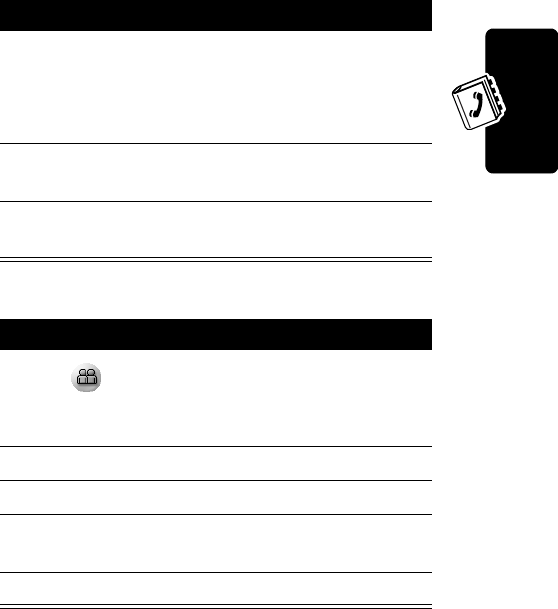
Draft
63
Contact List
Deleting Voice Tags
3
When prompted, tap
Record
again and repeat the
voice tag.
A checkmark (
o
) in the
Voice tag
box indicates the
voice tag has been recorded.
4
Tap the field next to the
Voice
tag
box, then select
Voice
call
or
Video
call
.
5
Repeat these steps to record additional voice
tags for this contact.
Action
1
Tap in the Application Selector bar or
Application Launcher to display your list of
contacts.
2
Tap a contact in the list.
3
Ta p
Edit
>
Edit
Contact
.
4
Tap the
Voice tag
box for the tag you want to
delete.
5
Ta p
Yes
.
Action
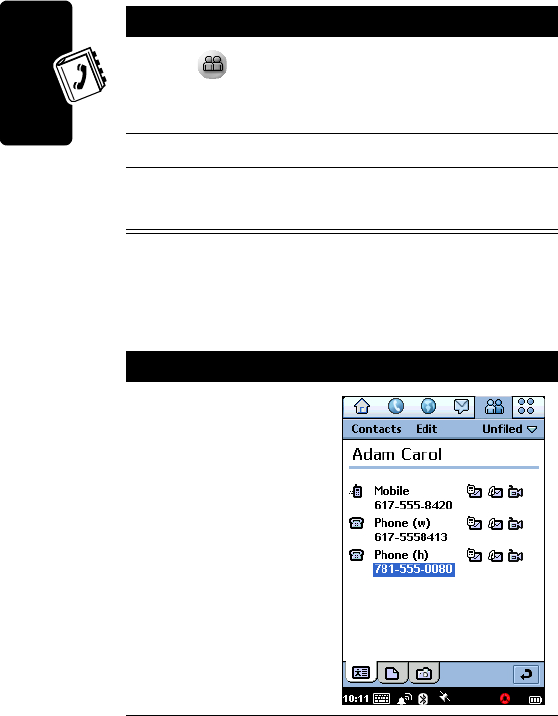
Draft
64
Contact List
Editing Contacts
Communicating with Contacts
You can easily phone, email, or send messages to your
stored contacts.
Action
1
Tap in the Application Selector bar or
Application Launcher to display your list of
contacts.
2
Tap a contact in the list.
3
Tap
Edit
>
Edit
Contact
.
Note:
Your changes are automatically saved.
Action
1
In the list of contact
entries, tap the
contact name. The
contact’s defined
phone numbers and
email addresses
display:
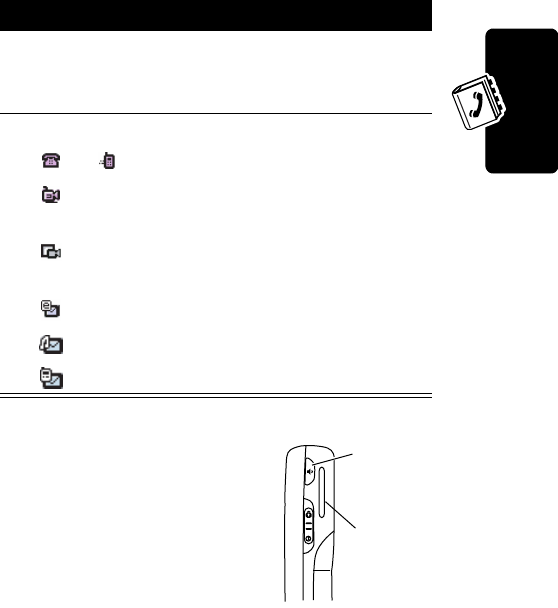
Draft
65
Contact List
Using Voice Dialing
Press and release
a
(speakerphone key) then say
the recorded voice tag within 2
seconds.
A phone number or email address might have
additional icons next to it, depending on its
defined communication method.
2
Tap the icon for the call or message you want:
or Voice Call to a phone
Video Call to a phone or computer (for
phone number contacts)
Video Call to a computer (for email address
contacts)
Email message to a phone or computer
MMS message to a phone or computer
SMS message to a phone
Action
Speakerphone
Key
Speakerphone
Port
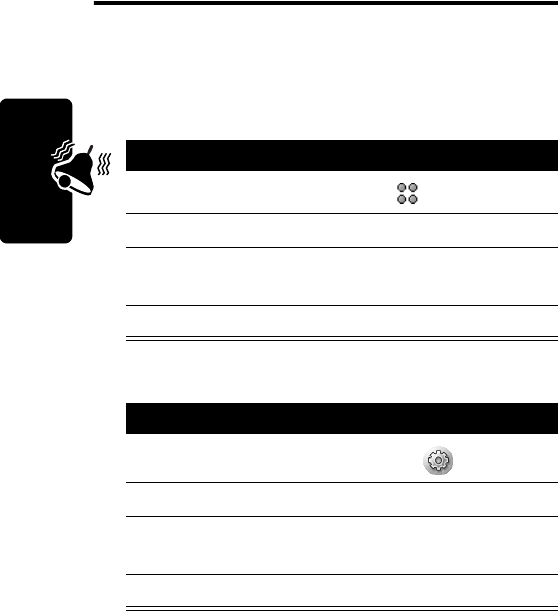
66
Draft
Customizing Communicator Settings
Customizing Communicator
Settings
Setting the Wallpaper Image
You can set an image to display in the background of the
Application Launcher.
Setting the Screen Brightness
Action
1
Open Application Launcher ( ).
2
Tap
View
>
Appearance
.
3
Tap
Background
and select from the list, or select
Find image
to select a stored image.
4
Tap
Done
.
Action
1
Open Control Panel application ( ).
Note:
Tap
Screen
from the
Handset
tab.
2
Slide the
Brightness
switch button to the desired
setting.
3
Tap
Done
.
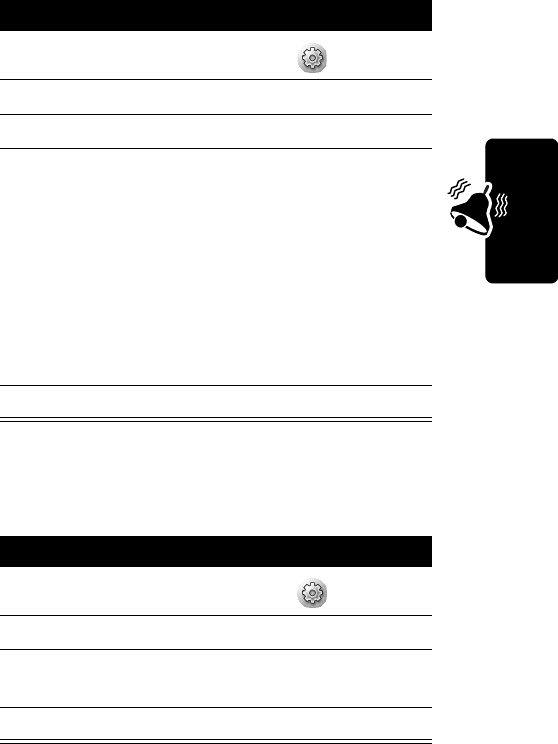
67
Draft
Customizing Communicator Settings
Setting the Screen Calibration
Setting the Volume for System Sounds
Set the volume level for screen taps, button presses,
alerts, and system notices.
Action
1
Open Control Panel application ( ).
2
Ta p
Screen
from the
Handset
tab.
3
Ta p
Calibrate
.
4
When prompted, tap the center of points 1, 2,
and 3 to calibrate the screen.
or
Press the center of the screen to reset
calibration to the factory default setting.
or
Press
S
in any direction to exit without making
changes.
5
Ta p
Done
.
Action
1
Open Control Panel application ( ).
2
Ta p
Sound
from the
Handset
tab.
3
Select desired settings for button clicks, screen
taps, ringer, and alert mode.
4
Ta p
Done
.
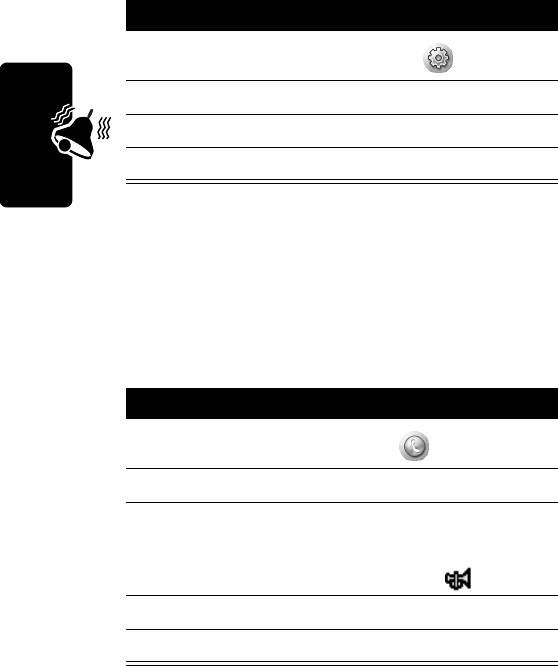
68
Draft
Customizing Communicator Settings
Setting a 3 Key Shortcut
The 3 key (
E
) has 1 default shortcut setting, Browser,
and one shortcut that you can customize to open your
favorite application, for example, Camera.
Choosing Ring Tones
When you set the alert mode to audio, the communicator
rings during an incoming call or message (see page 32).
Personalized ring tones assigned to stored contacts
override the ring tones you select here (see page 59).
Choosing Ring Tones for Calls
Action
1
Open Control Panel application ( ).
2
Tap
Shortcut key
from the
Handset
tab.
3
Select an application from the list.
4
Tap
Done
.
Action
1
Open the Phone application ( ).
2
Tap
Settings
>
Tones
.
3
Select the ring tones you want for line 1, line 2 (if
applicable), video, voicemail, and videomail.
To hear the selected ring tone, tap .
4
Select a setting for
Keypad
tones.
5
Tap
Done
.
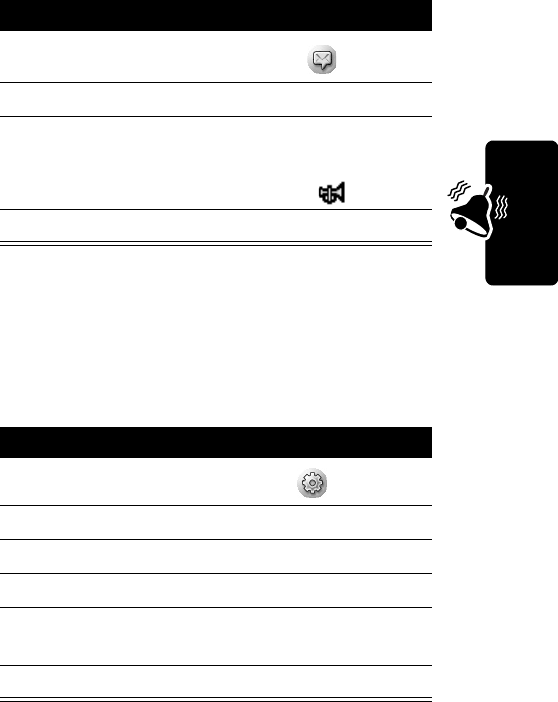
69
Draft
Customizing Communicator Settings
Choosing Ring Tones for Messages
Choosing a Vibrate Pattern
When you set the alert mode to vibrate, the communicator
vibrates to indicate an incoming call or message. You can
select from the different vibrate patterns provided.
Note:
See page 32 to view and set the alert mode.
Action
1
Open the Messaging application ( ).
2
Ta p
Edit
>
Preferences
.
3
Select the ring tones you want for each
messaging account.
To hear the selected ring tone, tap .
4
Ta p
Done
.
Action
1
Open Control Panel application ( ).
2
Ta p
General
tab.
3
Ta p
Ringtune Manager
.
4
Tap the
Vibrate
tab.
5
Tap the vibrate pattern you want to use. To test
the pattern, tap the left arrow.
6
Ta p
Done
.
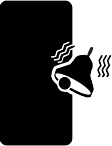
70
Draft
Customizing Communicator Settings

71
Draft
Getting More Out of Your
Communicator
Getting More Out of Your
Communicator
Installing the A1000 Desktop Suite
Important:
Before connecting your communicator to
another device such as a computer or Bluetooth device,
install the A1000 Desktop Suite, located on the in-box CD.
Follow the on-screen prompts for installation instructions.
This program enables you to establish a connection with a
computer or Bluetooth device to:
•
Synchronize email and Calendar, Contacts, and To Do
entries between your communicator and a
computer
•
Back up and restore information between your
communicator and a computer
•
Transfer files between your communicator and a
computer
•
Install applications on your communicator
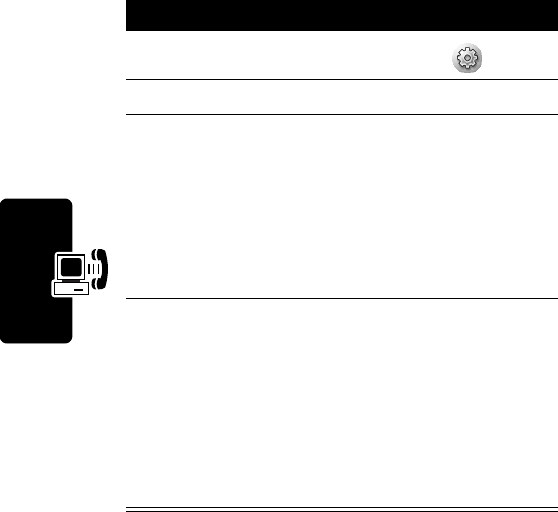
72
Draft
Getting More Out of Your
Communicator
Connecting a Bluetooth Device
Important:
Before connecting your communicator to a
Bluetooth device, set up the other device as described in
its user guide.
Action
1
Open Control Panel application ( )
2
Tap
Connections
tab >
Bluetooth
.
3
Tap the
Devices
tab, then tap
Add
.
Your communicator searches for all Bluetooth
enabled devices in the vicinity.
or
Tap
Show
, select from the list of available devices,
then tap
Refresh
,
4
In the list of available devices, tap the one you
want to bond.
If prompted, enter a passkey, then tap
Done
.
A passkey is a set of numbers or letters (at least
four characters) that you agree to exchange with
the owner of the other device. When the
communicator accepts the passkey, the bonding
process completes.
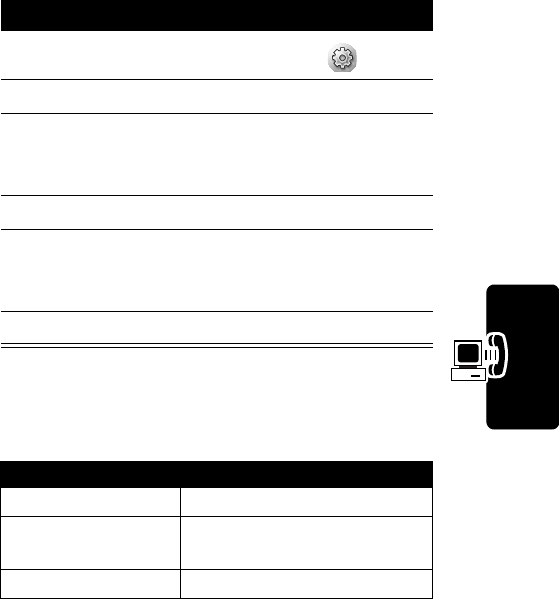
73
Draft
Getting More Out of Your
Communicator
Changing Your Bluetooth Settings
Receiving Items
settings determine what your
communicator does when it receives information from
connected Bluetooth devices.
Action
1
Open Control Panel application ( )
2
Ta p
Connections
tab >
Bluetooth
>
Settings
tab.
3
To turn on Bluetooth, tap the box next to
Bluetooth
on
. A check mark in the box indicates Bluetooth
hardware is turned on.
4
Tap a selection in
Visible for other devices
.
5
You can change your
Receiving items
settings (see
below), and enter a Bluetooth name for your
communicator.
6
Ta p
Done
.
Setting Description
Always receive
accepts the information
Ask first
prompts you to accept the
information
Never receive
rejects the information
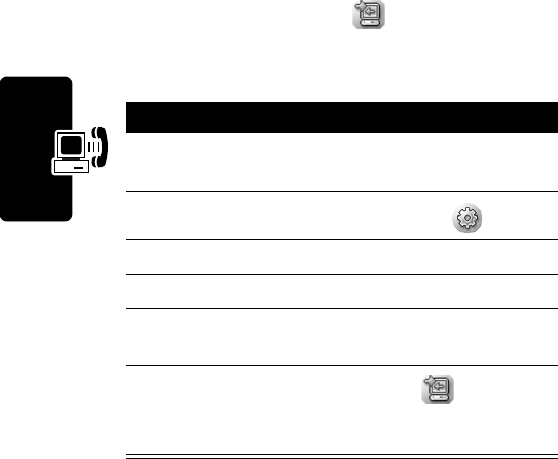
74
Draft
Getting More Out of Your
Communicator
Connecting to a Computer
Important:
Before connecting your communicator to a
computer, ensure the A1000 Desktop Suite, located on the
in-box CD has been installed.
Setting Up a USB Cable Connection
Connect the USB cable from the accessory port on the
bottom of the communicator to the USB port on the
computer.
To complete the connection, tap (
Desktop Suite
) in the
Application Launcher, then tap
Connect
.
Setting Up a Bluetooth Connection
Action
1
Make sure the PC is Bluetooth enabled, then
establish a connection as described on page 72.
2
Open Control Panel application ( )
3
Tap
Connections
tab >
Desktop Suite
.
4
In the
Link using
, field tap
Bluetooth
.
5
To select a
Preferred PC
, tap the box next to it,
then tap
Done
.
6
To complete the connection, tap (
Desktop
Suite
) in the Application Launcher and tap
Connect
.
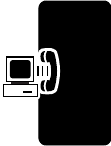
75
Draft
Getting More Out of Your
Communicator
Using the Desktop Suite
After connecting your communicator to the computer, start
the A1000 Desktop Suite program on the computer. Refer
to the A1000 Desktop Suite online help for more
information about using the program.
Using Remote Synchronization
The communicator allows you to synchronize Calendar, To
Do, and Contract entries over the air (OTA) with a
synchronization server. It is designed to synchronize with
basic features of the initial release of many popular
Personal Information Management (PIM) software and
hardware products.
Setting Up Your Account
To use remote synchronization, contact your service
provider to set up an account. To synchronize over the
Web, you also need an Internet account.
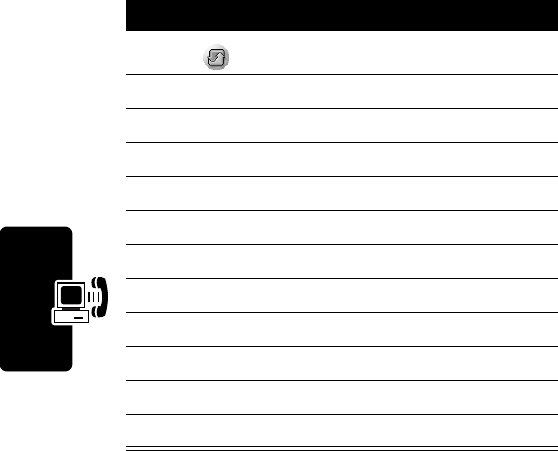
76
Draft
Getting More Out of Your
Communicator
Configuring the Settings
When you have your account information, you can
configure the communicator for remote synchronization.
Action
1
Tap ( ).
2
Tap
Edit
>
Settings
.
3
Enter the
Server address
,
Username
, and
Password
.
4
Tap
Done
.
5
Tap on a task you want to enable.
6
Tap
Enable task
checkbox.
7
Enter the path to the
Server database
.
8
Tap
Done
.
9
Tap
Edit
>
Settings
, then tap the
Protocol
tab.
10
Tap
Use transporter login
checkbox.
11
Enter a
Username
and
Password
.
12
Tap
Done
.
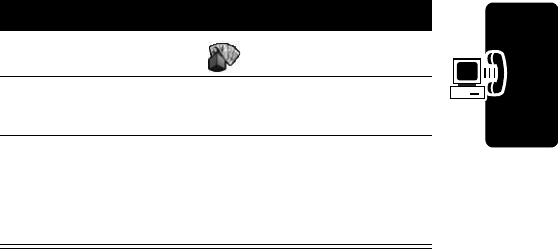
77
Draft
Getting More Out of Your
Communicator
Using Picsel Viewer
Picsel Viewer automatically reformats many popular file
formats such as text, presentation, and database
management files, to fit in the display area of your
communicator.
Use Picsel Viewer to open documents from the internet,
received messages, and documents stored on your A1000
communicator or personal computer. The stylus and icons
allow you to open, scroll, zoom, and navigate through
documents with ease.
Opening Documents
Action
1
Open Picsel Viewer ( ).
2
Locate the document from your saved
Bookmarks
,
History
list, folders, or lists.
3
Tap on the document name to open it.
Document
options allows you to display and select
options such as send, delete, rename, view
history, and bookmarks.
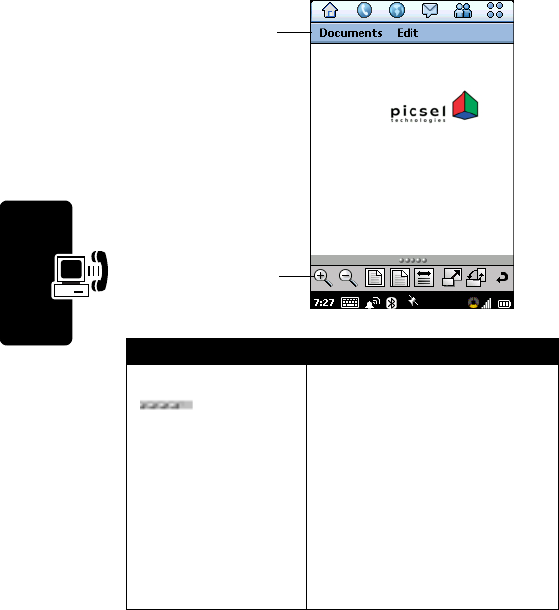
78
Draft
Getting More Out of Your
Communicator
Navigating Documents
Icons on the navigation bar allows you to easily zoom in
and out, change views, and move to other pages of the
document.
Navigation Icon Description and Procedure
Expand control bar
()
Displays thumbnail images of
a document 3 pages at a
time. The larger thumbnail
indicates the currently
displayed page. Tap a
thumbnail to display its page.
Tap the left arrow twice to go
to the first page, tap the right
arrow twice to go to the last
page.
Document
Options
Navigation
Icons
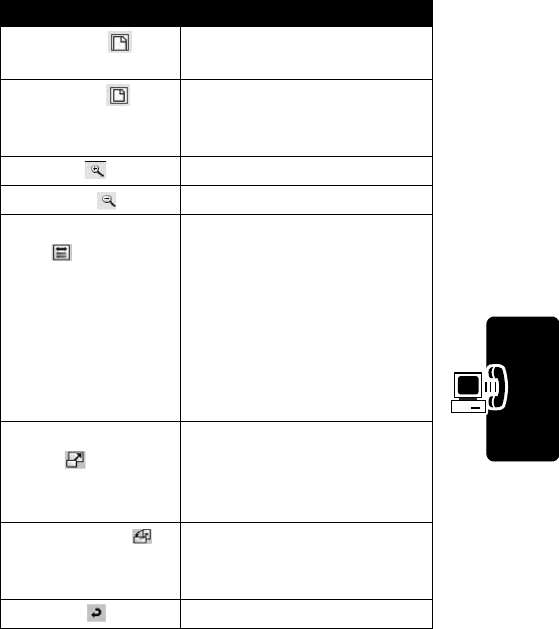
79
Draft
Getting More Out of Your
Communicator
Fit to width ( ) Display a document to the full
width of the viewing area.
Fit to page ( ) Display a document to the full
width and height of the
viewing area.
Zoom in ( ) Increase document size
Zoom out ( ) Decrease document size
Display as actual
size ( )
Display a document or image
in its full, original size.
Tapping the Expand control
bar displays thumbnails for
easier navigation. Tap and
hold the red box in the
thumbnail to move around the
current screen.
Full screen
mode ( )
Display a document or image
in its full, original size and
hides the status and
application bars.
Rotate screen ( ) Rotate screen horizontally.
Tap again to go back to
vertical view.
Go back ( ) Display previous page
Navigation Icon Description and Procedure

80
Draft
Getting More Out of Your
Communicator
Setting Preferences
Action
1
Tap
Edit
>
Preferences
.
2
Make your selections from the list.
Page flick
– go to the next or previous page in a
document by tapping and sliding the stylus
across the bottom of the display.
•
Slide stylus right to go to the previous page
•
Slide stylus left to go to the next page.
Show pictures
– available only for HTML and PDF
documents
Reflow text
– reformats documents to fit the width
of the display.
Keep for
– select the number of days documents
are kept before they are automatically deleted.
Clear history
– delete all history documents
3
Tap the filename to open the document.

81
Draft
Personal Organizer Features
Personal Organizer
Features
Calendar
Use Calendar to schedule and organize events such as
appointments and meetings. You can review your schedule
of events for the day, week, or month, and have the
communicator play a reminder alarm for specific events.
Note:
Ensure the correct time and date are set before
using Calendar (page 88).
Adding a Calendar Entry
You can enter the following types of Calendar entries:
•
Appointment
– An entry with a start and end time (for
example, a meeting)
•
Reminder
– An entry that does not need a time (for
example, a birthday)
•
All day event
– An entry with a start and end date,
but no specific times. Use an all day event for an
entry that lasts a whole day or several days (for
example, a conference).
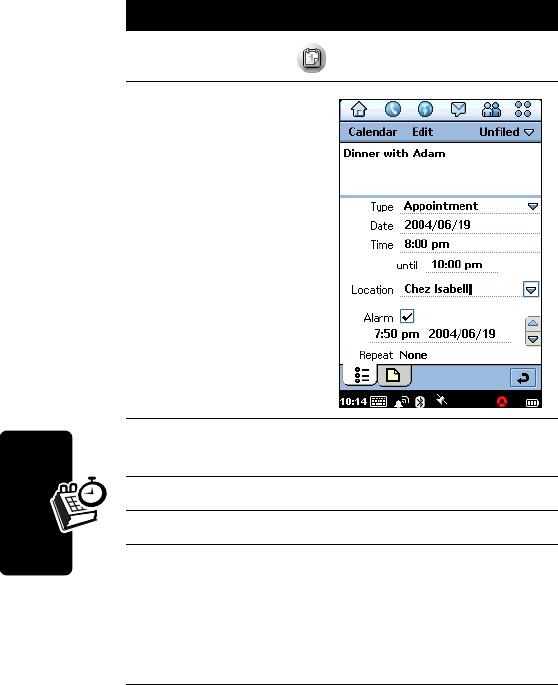
82
Draft
Personal Organizer Features
To add a Calendar entry:
Action
1
Open Calendar ( ).
2
Tap
Calendar
>
New.
The Calendar Entry
form displays.
3
Use the stylus or virtual keyboard to enter a
description.
4
Select the type of entry.
5
Enter the date, time, and location of the event.
6
Tap the
Alarm
box if you want the communicator
to sound a reminder alarm for this entry.
The time and date of the alarm display below the
Alarm
box. To change when the alarm sounds,
tap the time or date.
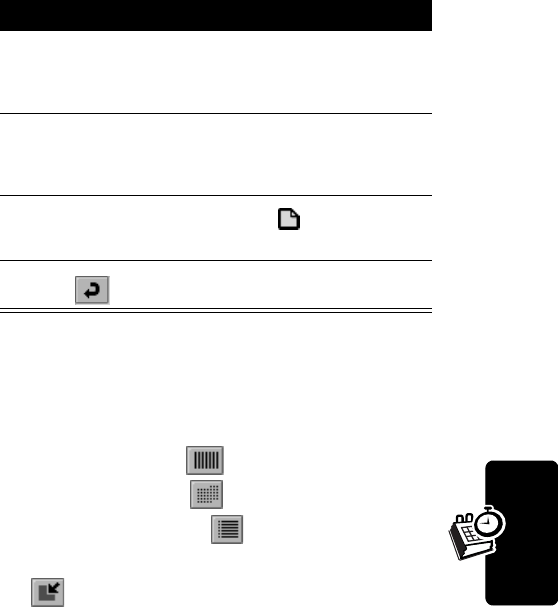
83
Draft
Personal Organizer Features
Switching Calendar Views
You can see your Calendar entries in several views: Day,
Week, or Month. When you first open Calendar, the Day
view displays.
To switch to Week, tap .
To switch to Month, tap .
To switch back to Day, tap .
To return to the current day in the selected view,
tap .
To see the details of an entry, tap the entry.
7
If this entry recurs, tap
Repeat
to select a repeat
interval. Check the
Forever
box to have the alarm
repeat indefinitely.
8
To mark this entry as Private when you
synchronize Calendar entries with a computer,
tap
Private
.
9
To add a note to the entry, tap , then enter the
note.
10
Tap to save the entry.
Action

84
Draft
Personal Organizer Features
Moving Entries to the To Do Application
You can move Calendar entries to the To Do application,
which lists tasks you need to complete.
Notes:
To Do entries do not have repeats, times, or
locations, so Calendar entries that you move to To Do lose
this information. If you copy an entry back to Calendar, the
information is not restored. If you move an entry with an
alarm, it sounds in To Do.
To Do
Use the To Do application to list and track tasks you need
to complete. You can set due dates for activities, reminder
alarms, and mark tasks as completed.
Action
1
Open the entry.
2
Tap
Calendar
>
Move to To do
.
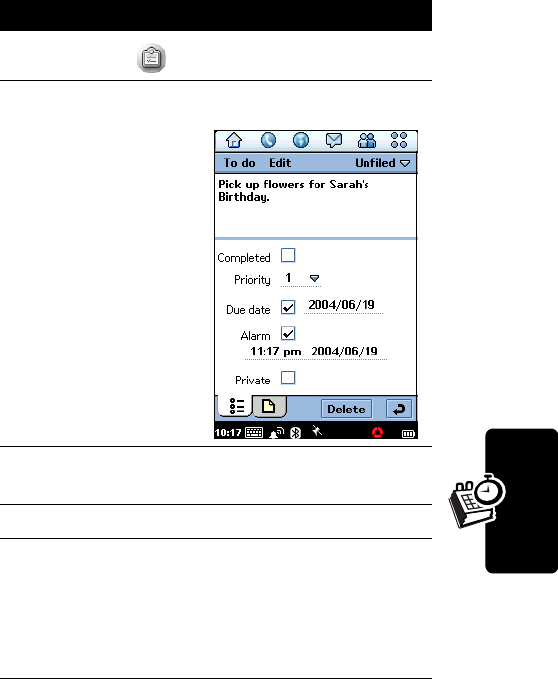
85
Draft
Personal Organizer Features
Adding Entries:
Action
1
Open
To do
().
2
Ta p
To do
>
New
.
The To Do entry
form displays.
3
Use stylus or virtual keyboard to enter a
description.
4
Select a priority (1-9, with 1 highest) for the task.
5
Tap the
Due date
box if you want to this task to
have a due date.
The current date displays next to the
Due date
box. To select a different due date, tap the date,
and select a date from the displayed calendar.
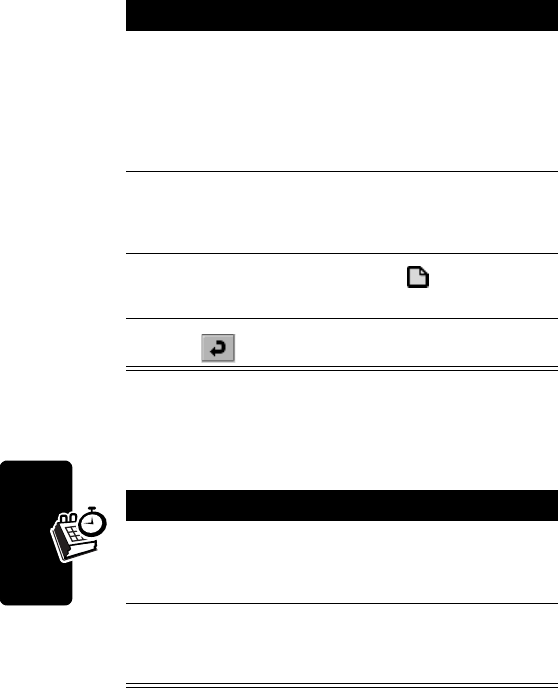
86
Draft
Personal Organizer Features
Marking Tasks as Complete
When you open To Do, a list of tasks and their due dates
displays.
6
Tap the
Alarm
box if you want the communicator
to sound a reminder alarm for this entry.
The time and date of the alarm displays below
the
Alarm
box. To change the alarm, tap the time
or date.
7
To mark this entry as Private when you
synchronize To Do entries with a computer, tap
Private
.
8
To add a note to the entry, tap and enter the
note.
9
Tap to save the entry.
Action
To mark a task as completed, tap the box next to it.
The due date disappears, indicating the task is
completed.
Note:
To hide completed entries, tap
Edit
>
Preferences
, then remove the check from
Display
completed
.
Action

87
Draft
Personal Organizer Features
Deleting Entries
When you no longer need a record of your completed
entries, delete them.
Moving Entries to Calendar
You can schedule To Do entries on your calendar by
moving them to the Calendar application (page 81).
Notes:
If you do not set a due date for the To Do entry,
the communicator uses the current date for the new
entry.
If you move an entry with an alarm, it sounds in
Calendar.
Action
To delete an individual entry, tap the entry in the list
and tap
Delete
.
To delete all completed entries, in your list of entries,
tap
To do
>
Delete completed
.
Action
1
Open the entry.
2
Ta p
To do
>
Move to Calendar
.
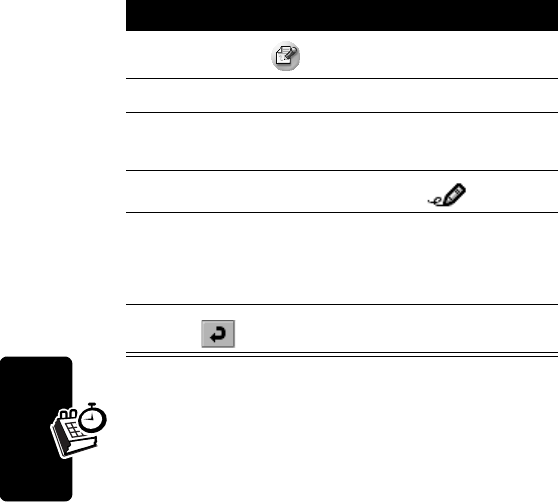
88
Draft
Personal Organizer Features
Notes
Use Notes to write notes and sketch graphics.
Adding Notes
Time
Use Time to set the current time and date, and to set
alarms you do not want to include in your Calendar or
To Do list.
Action
1
Open Notes ( ).
2
Tap
Notes
>
New
.
3
Enter the note using the stylus or virtual
keyboard.
4
To add a graphic to the note, tap .
5
Use the stylus to sketch your graphic.
Use the on-screen buttons to change line width
and color, and erase lines.
6
Tap to save the note.
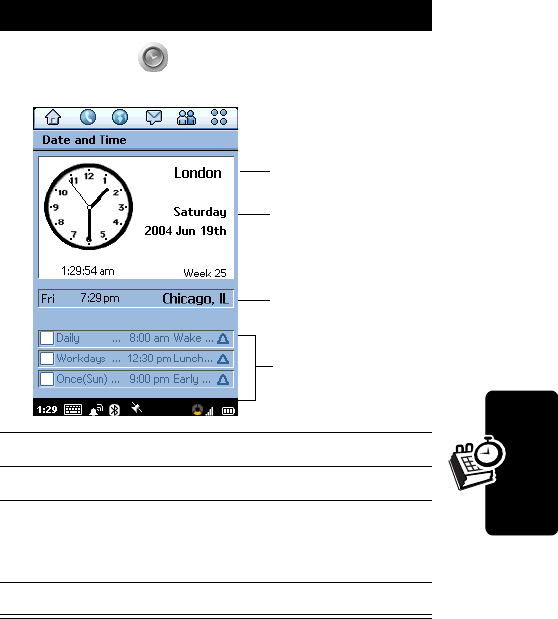
89
Draft
Personal Organizer Features
Setting the Time and Date
If you have not already set the current time and date:.:
Action
1
Open Time ( ). The Date and Time screen
displays:
2
Ta p
Time
>
Set time & date
.
3
Enter the current time and date.
4
To set the time and date format, tap the
Format
tab, then select the format from the lists of
available formats.
5
Ta p
Done
.
Current time and
date
Other city time
and date
Alarm slots
Current city

90
Draft
Personal Organizer Features
Setting Location
Time can display time and date information for two
locations:
•
Current
– The place where you are at the moment. The
time and date of your current location display in the
top half of the screen.
•
Other
– A city of your choice. The time and date of this
city displays below the time and date of your current
location. If you are abroad, you can check the time at
home by setting this location to your home city.
Action
1
Tap
Date and Time
>
Set location
.
2
Select your current location from the
Current
country
and
Current city
lists.
Note:
If the city you want is not listed, select another
city in the same time zone.
3
Select another location (optional) from the
Other
country
and
Other city
lists.
4
Tap
Done
.
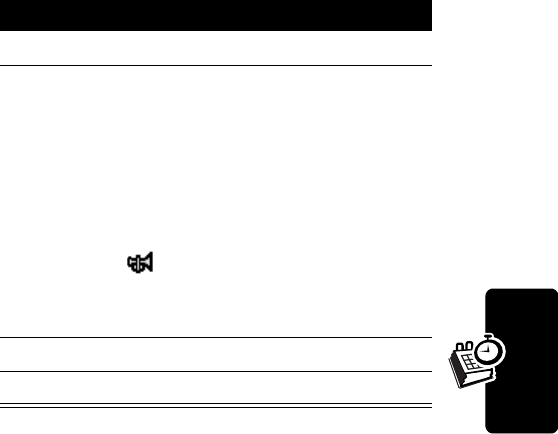
91
Draft
Personal Organizer Features
Setting Alarms
You can use Time as an alarm clock. It is ideal for wake-up
alarms and other regular alarms you do not want to include
in your Calendar or To Do list.
You can set up to three alarms in Time. The alarm slots
display in the lower half of the Time screen.
Responding to Alarms
When an alarm sounds, the message you selected
displays. Tap the
Snooze
button to reset the alarm to sound
again in 5 minutes.
Note:
The alarm does not sound while you are making a
phone call or recording a voice note.
Action
1
Tap one of the alarm slots.
2
Set the following alarm details:
Time
– time of day you want the alarm to sound.
When
– how often you want the alarm to sound:
once, during the next 24 hours, daily, on
workdays only, or weekly.
Alarm sound
– the sound you want the alarm to
make. Tap to listen to the selected sound.
Message
– one of several preset alarm messages
or enter your own.
3
Ta p
Done
.
4
Tap the alarm checkbox to turn on the alarm.
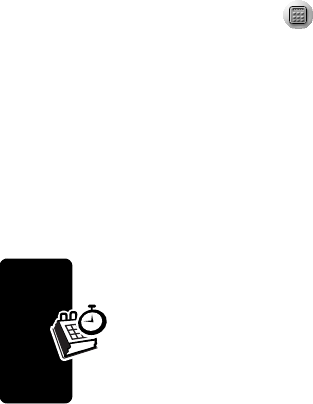
92
Draft
Personal Organizer Features
Turning Alarm Sounds Off
To silence an alarm before it sounds, do one of the
following:
•
Uncheck the alarm slot checkbox.
•
Tap the alarm slot, then select
Silent
in
Alarm sound
.
Calculator
To open Calculator, tap in the Application Launcher.
Use the calculator by tapping the on-screen keys.
Making Voice Recordings
You can record personal messages on your communicator.
Note:
Recording of phone calls is subject to varying State
and Federal laws regarding privacy and recording of phone
conversations.
Tip:
Make your recording in a quiet location. Hold the
communicator about 4 inches (10 centimeters) from your
mouth, and speak directly into the communicator in a
normal tone.
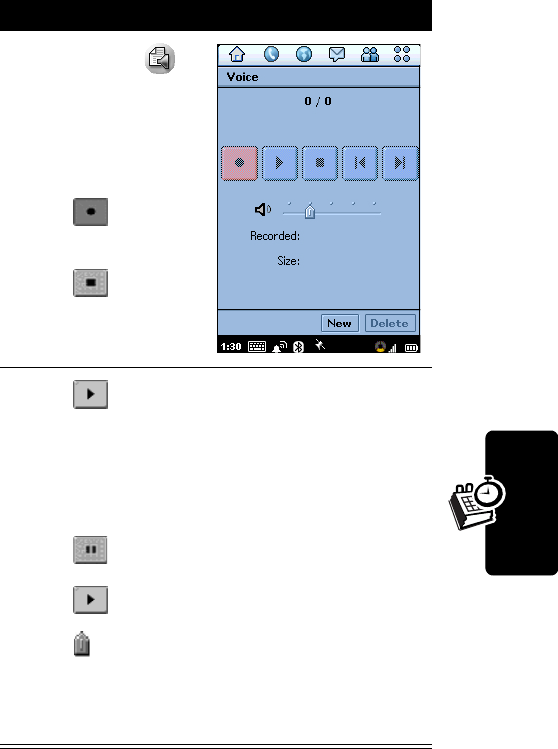
93
Draft
Personal Organizer Features
Tip:
Adjust your volume setting for playback.
Action
1
Open Voice ( ).
2
Ta p
Voice
>
New Voice
note
or tap
New
(at
the bottom of the
screen).
3
Tap to begin
recording.
4
Tap to stop
recording.
5
Tap to playback the recording.
A counter at the top of the screen indicates the
number of the current recording and the total
number of recordings. For example,
1/2
indicates you are on the first of two records.
Tap to pause during playback.
Tap to resume playback.
Tap and slide left to decrease volume or right
to increase volume during playback.
To delete a recording, tap
Delete
while on the
record.
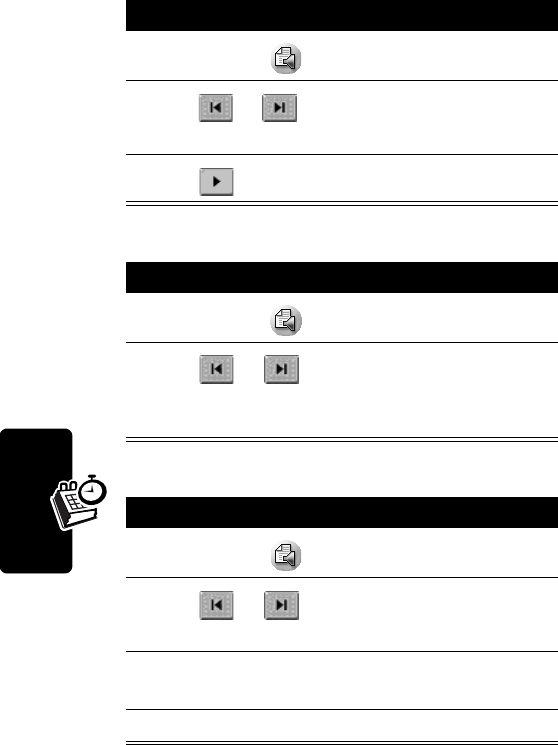
94
Draft
Personal Organizer Features
Playing a Recording
Deleting a Recording
Sending a Recording
Action
1
Open Voice ( ).
2
Tap or to go to the recording you want
to play.
3
Tap to play the recording.
Action
1
Open Voice ( ).
2
Tap or to scroll to the recording you
want to delete, then tap
Voice
>
Delete
note
or tap
Delete
(at the bottom of the screen).
Action
1
Open Voice ( ).
2
Tap or to scroll to the recording you
want to send, then tap
Voice
>
Send as
.
3
Tap one of the selections in the
Send as
box, then
press
Done
.
4
Follow the normal procedure for your selection.
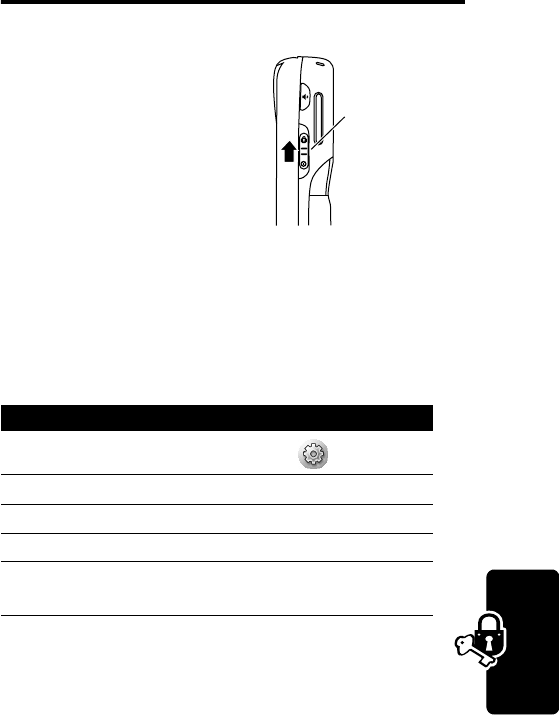
95
Security
Draft
Security
Locking and
Unlocking
Communicator
You can lock the communicator
so that the touchscreen and
keys do not work. When you
lock the communicator, you
can still use the
B
and
A
keys for incoming phone calls.
Establishing Password Protection
You can establish password protection to prevent
unauthorized access to information in the communicator.
Action
1
Open Control Panel application ( ).
2
On the
Handset
tab, tap
Password
.
3
Tap the
Security
tab, then tap
Set
Security
Code
.
4
Tap in your current security code, then tap
Done
.
5
Enter a new security code, then tap
Done
.
Confirm the new security code, then tap
Done
.
Slide up to
lock. Slide
down to
center to
unlock.

96
Security
Draft
6
To set a phone lock code, tap
Phone Lock
>
Set lock
code
. Enter a lock code, then tap
Done
. Confirm
the lock code, then tap
Done
.
Tap the
On
or
Off
button for
Auto Phone Lock
.
To delete the code, tap
Clear
, enter your current
code, then tap
Done
.
7
If you want the password entry screen to display
owner information:
a
Tap
Owner
.
b
In the
Owner Information
box, enter the text
that you want displayed.
c
Tap
Done
.
Action

97
Draft
News and Entertainment
News and Entertainment
Web Browser
The Web browser lets you open Web
pages and use Web-based applications (such
as on-line banking, shopping, and games) on
your communicator.
Setting Up Your Internet Account
Before you can use the Web browser, you must set up an
Internet account (see page 50).
Opening Web Browser
Tap in the Application Launcher or Application
Selector Bar.
To open the Web browser and go directly to the Hutchison
portal, press
E
.
If you have saved bookmarks and/or Web pages, an
alphabetical list of your bookmarks or saved Web pages
displays, depending on which you displayed last.
Note:
If your bookmarks or saved pages do not display, tap
Browse
>
Bookmarks
or
Saved pages
.

98
Draft
News and Entertainment
Opening Web Pages
Adding Bookmarks
To add a bookmark for a Web page so you can return to
the page without having to enter its address:
Action
1
Tap the bookmark or saved Web page you want
to open.
2
Tap
Browse
>
Open new
. Enter the Web page
address, in the
Location
field, then tap
Open
.
Note:
you can omit the
http://
.
3
Change the
Title
if desired, then tap
Save
.
Action
1
Open the Web page.
2
Tap
Browse
>
Page information
.
3
Tap
Bookmark
.
Note:
You can change the Title before saving the
bookmark, if desired, in the
Title
field.
4
Tap
Add
.

99
Draft
News and Entertainment
Saving Web Pages
To save a Web page so you can view it later when not
connected to the Internet (offline browsing):
Downloading Audio, Video, and Pictures
You can download audio files, video clips, and pictures
from the Web. To download a file, follow the instructions on
the Web page.
When the download completes, the file opens in the
browser or in another communicator application
(depending on the file type). You can save the file to a
folder in the communicator or to the memory card.
You need a license to open media files that
have digital rights protection. If you do not
have a license for a protected file, your
communicator prompts you to launch the
Web browser and download one.
Action
1
Open the Web page.
2
Ta p
Browse
>
Page information.
3
Ta p
Save
and change the
Title
if desired.
Note:
You can change the Title before saving the
page, if desired, in the
Title
field.
4
Ta p
Save
.
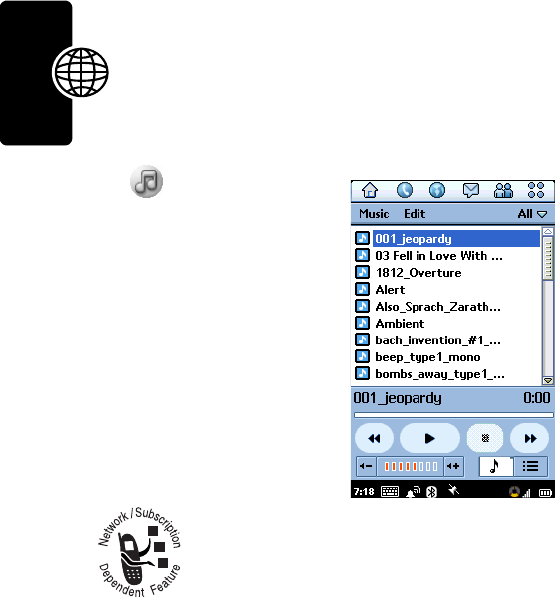
100
Draft
News and Entertainment
Music
Use Music to listen to the following types of audio files: AU,
AMR, MIDI, MP3, and WAV. You can listen to audio
files that you downloaded from the Web, received as an
email attachment, or stored on the removable memory
card.
Opening Music
Tap in the Application
Launcher. When Music
opens, it shows a list of all
saved audio tracks.
To see the audio tracks saved
in a specific folder, tap the
current folder name (upper
right corner) and select the
desired folder from the list.
Sample music files are
provided on the CD supplied
with the communicator.
You need a
license to open media files that have digital
rights protection. If you do not have a license
for a protected file, your communicator
prompts you to launch the Web browser and
download one.

101
Draft
News and Entertainment
Note:
Audio tracks must be stored in the proper directory
on the memory card for you to see and play them in Music.
When you copy audio files to the memory card from a
computer, ensure that the files are stored in a third-
level directory under:
Media Files\Audio\
For example, you can store audio files in any of the
following directories:
Media Files\Audio\Classical
Media Files\Audio\Rock
Media Files\Audio\Unfiled
Playing an Audio Track
Action
1
In the list of tracks, tap the track you want to play.
Information about the track displays (artist,
album, etc.) and the track begins to play.
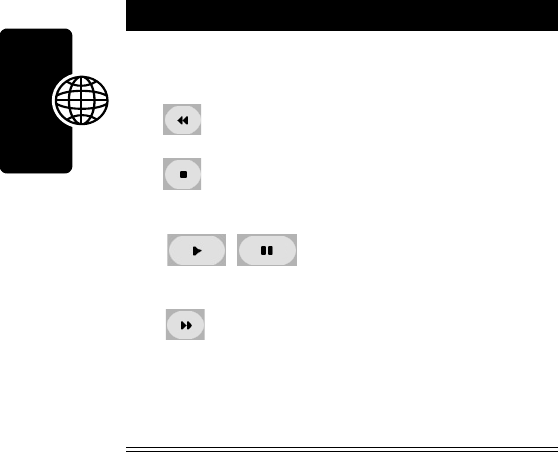
102
Draft
News and Entertainment
2
While the track plays, you can tap the following
buttons at the bottom of the screen:
Tap and hold down to rewind the track.
Tap to stop playing and return to the start of
the track.
Tap to switch between play and
pause mode.
Tap and hold down to advance (fast
forward) the track.
Note:
The
S
key also controls audio play:
left = rewind, right = fast forward, center = play/
pause.
Action
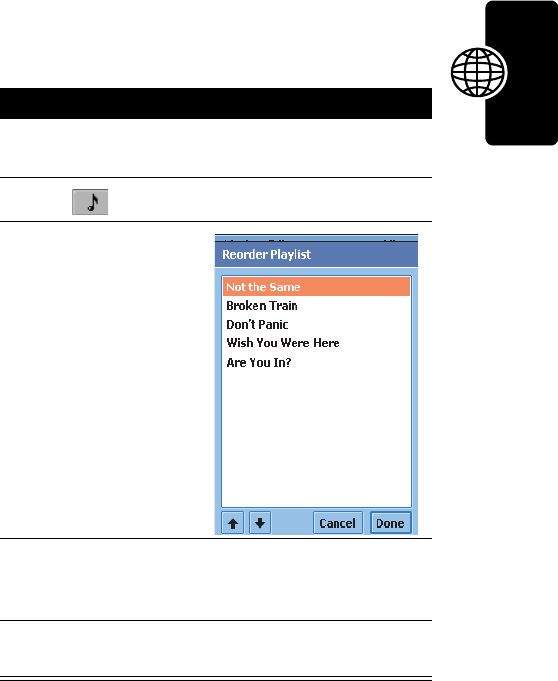
103
Draft
News and Entertainment
Managing Music Playlists
Music can play all of the tracks in a folder in a sequence
that you specify. To specify the sequence, you must edit
the folder’s playlist:
Action
1
Open the folder containing the tracks you want to
play.
2
Tap to switch to Playlist view.
3
Ta p
Edit
>
Edit
Playlist
. The Reorder
Playlist screen
displays:
4
To arrange the sequence, tap a track and then
tap the arrows to move it up or down in the
sequence.
5
When the tracks are arranged in the sequence
you want, tap
Done
.
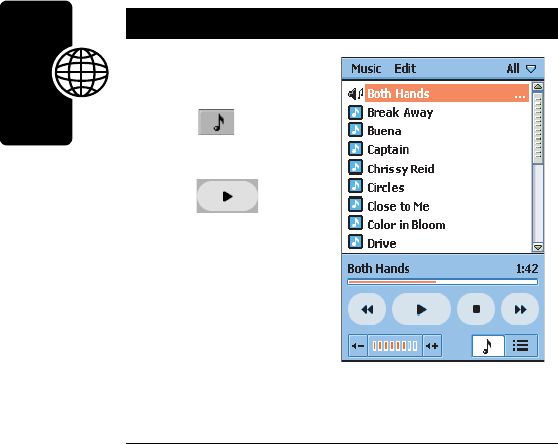
104
Draft
News and Entertainment
Playing a Music Playlist
Action
1
Open the desired
folder.
2
Tap to switch
to the Playlist view
3
Tap to play
the highlighted track
or
Select a track by
tapping on it. The
track automatically
starts playing.
The Music Player plays the tracks in the
sequence you selected.
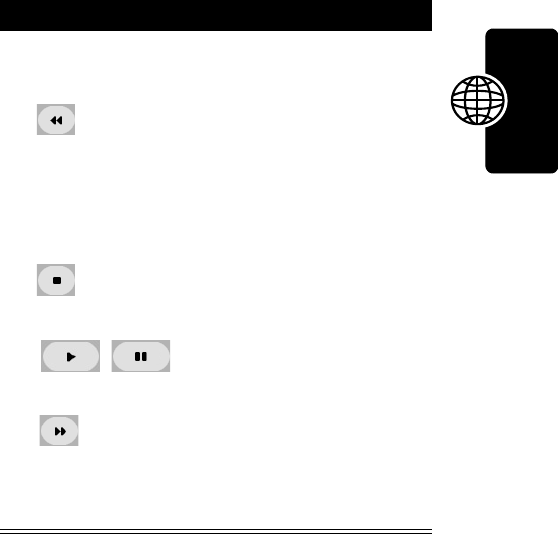
105
Draft
News and Entertainment
4
While the playlist plays, you can tap the following
buttons at the bottom of the screen:
Tap and release to start playing from the
beginning of the current track or to jump to the
beginning of the previous track in the playlist (if
already at the start of the current track).
Tap and hold down to rewind the current track.
Tap to stop playing and return to the start of
the track.
Tap to switch between play and
pause mode.
Tap and release to start playing from the
beginning of the next track in the playlist.
Tap and hold down to advance (fast forward) the
current track.
Action
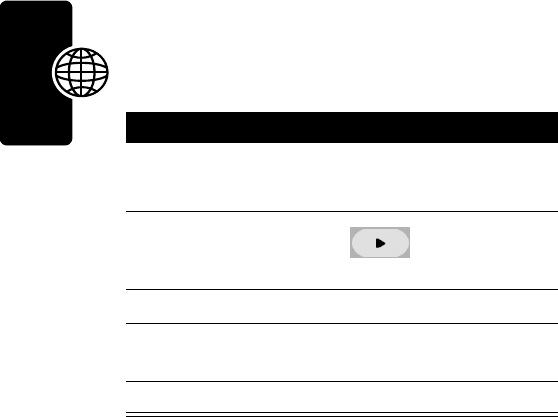
106
Draft
News and Entertainment
Saving Audio Files
When you download an audio file from the Web or open an
audio email attachment, the
Save Audio File
screen
displays. To save the file to a folder in the
communicator or to the Memory card:
Note:
To ensure optimum use of communicator memory,
save audio clips to the memory card when possible.
Action
1
Tap the down arrow to the left of the filename.
The
File information
screen displays.
2
In the
Audio
screen, tap to play the audio
file, or the right arrow to install as a Ring Tone.
3
Tap
Save
.
4
Select the location to which you want to save the
file.
5
Tap
Save
.
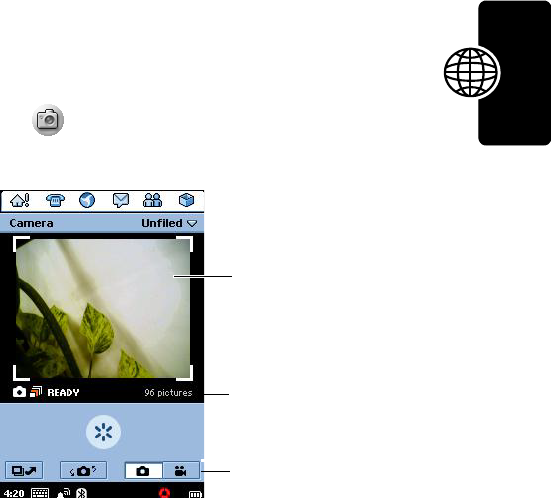
107
Draft
News and Entertainment
Camera
You can use the built-in camera to take still pictures and
record video clips.
Opening Camera Application
Tap in the Application Launcher. When the
Camera application opens, a camera viewfinder displays
the image viewed by the camera lens.
Viewfinder
Camera Mode buttons
(Still and Video)
Memory available
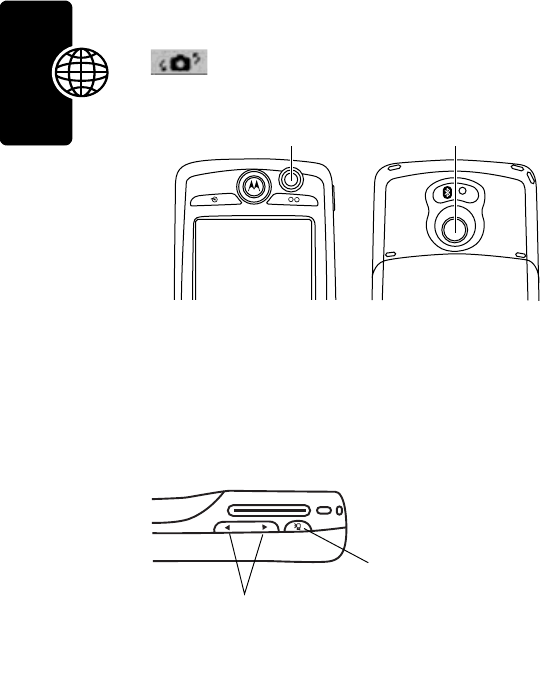
108
Draft
News and Entertainment
Using the Front and Back Camera Lens
You can use the front or back of the camera to take
pictures. To switch between the front or the back lens,
tap .
Using the Camera Control Keys
You can hold you communicator like you would hold a
standard camera to take pictures. When in camera mode,
the volume keys are used for zooming the image in and
out.
VGA Camera,
Point to Point (P2P) 1.2 Mega Pixel
Press the right side to
zoom in, and the left
side to zoom out.
Press to take a
picture.
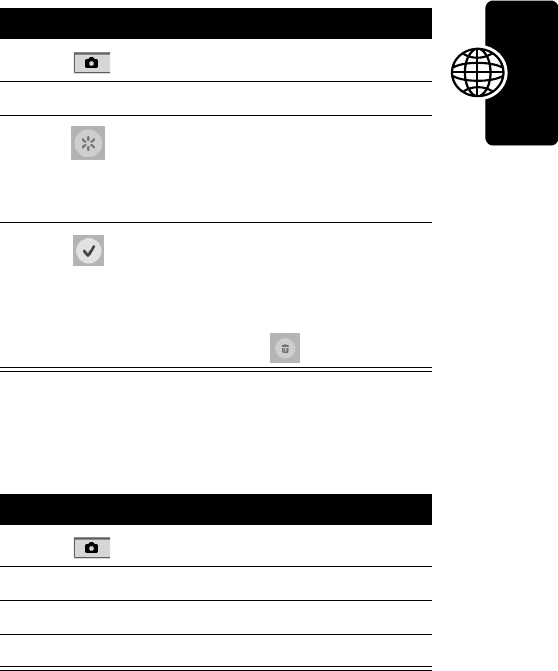
109
Draft
News and Entertainment
Taking Still Pictures
Selecting Camera Settings
You select the picture size, quality, lighting, and flicker
settings.
Action
1
Tap to place camera in Still mode.
2
Point the camera lens at the subject.
3
Tap or press
C
(center key) to take the
picture.
The picture displays in the viewfinder.
4
Tap or press
C
(center key) to save the
picture.
If you want to delete the picture without saving it,
press
C
(right arrow) or tap .
Action
1
Tap to place camera in Still mode.
2
Ta p
Camera
>
Camera settings
.
3
Select the desired settings.
4
Ta p
Done
.
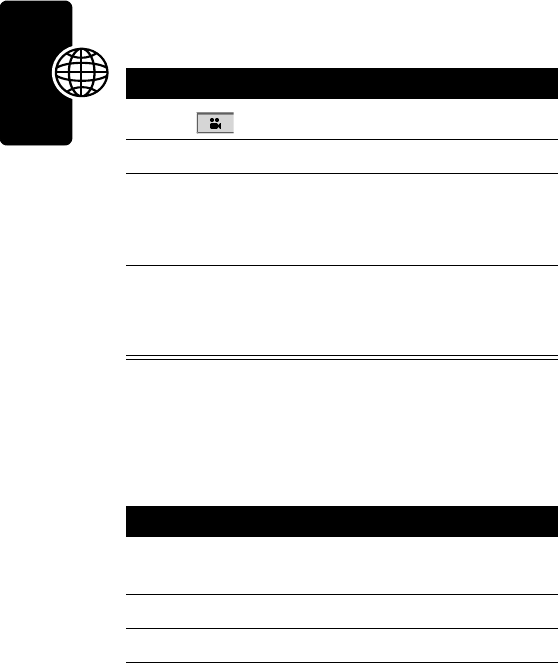
110
Draft
News and Entertainment
Recording Video Clips
You can use the camera to record a video clip up to 60
seconds long.
Using Self-Timer
The camera has a self-timer that automatically takes a
picture or records a video clip 5 seconds after you turn it
on.
Action
1
Tap to place camera in Video mode.
2
Point the camera lens at the subject.
3
Press
C
(center key) and hold for 2 seconds to
start recording the video.
The video image displays in the viewfinder.
4
To stop recording, press
C
(center key) again.
The video is saved to the currently selected
folder.
Action
1
Set camera to desired mode (still or video), as
described in the previous sections
2
Point the camera lens at the subject.
3
Tap
Camera
>
Self timer on
.
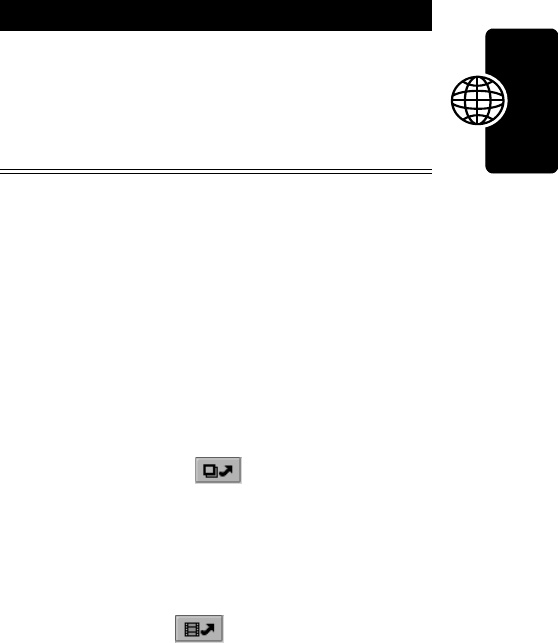
111
Draft
News and Entertainment
Available Memory Indicator
The available memory indicator below the viewfinder
shows an estimation of how many more pictures or video
clips you can take before the selected folder’s memory is
full. When memory is full, the camera stops recording.
Switching to Pictures
When the Camera is in Still mode, you can quickly switch
to
Pictures
to view, edit, and send the pictures you have
taken. See “Pictures” on page 116.
To switch to
Pictures
, tap .
Switching to Video
When the Camera is in Video mode, you can quickly
switch to
Video
to watch and send the video clips you have
recorded. See “Video” ahead.
To switch to
Video
, tap .
4
Press
C
(center key) and hold for 1 seconds to
start the timer.
The camera starts counting down from 5 to 0.
When it reaches 0, it takes the picture or starts
recording.
Action

112
Draft
News and Entertainment
Video
Use Video to watch video clips and streaming video and
audio from the Web. You can watch video clips that you
recorded with the communicator’s camera, downloaded
from the Web, received as an email attachment, or
stored on the removable memory card.
Opening Video
Tap in the Application Launcher. When Video opens,
it shows a list of all saved video clips.
To view the video clips saved in a specific folder, tap the
current folder name (upper right corner) and select the
desired folder from the list.
Sample video files are provided on the in-box CD supplied
with the communicator.
You need a license to open media files that
have digital rights protection. If you do not
have a license for a protected file, your
communicator prompts you to launch the
Web browser and download one.
Note:
Video clips must be stored in the proper directory on
the memory card for you to see and play them in Video.
When you copy video files to the memory card from a
computer, ensure that the files are stored in a third-level
directory under:
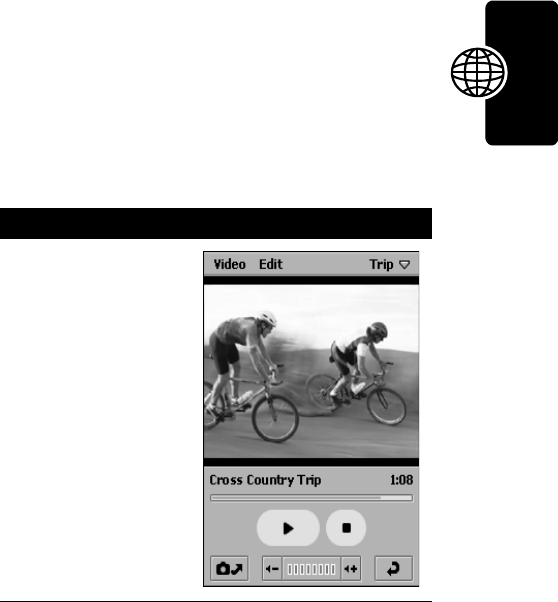
113
Draft
News and Entertainment
Media Files\Video\
For example, you can store video files in any of the
following directories:
Media Files\Video\Movie Trailers
Media Files\Video\Home
Media Files\Video\Unfiled
Playing a Video Clip
Action
1
In the list of video
clips, tap the clip
you want to play.
The video begins
to play in portrait
(vertical) view:
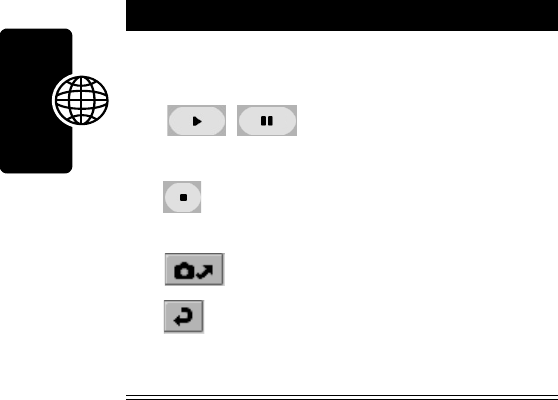
114
Draft
News and Entertainment
To see the video in landscape (full-screen) view, tap
anywhere on the playing video. To return to portrait view,
tap the playing video again.
Playing Streaming Video and Audio
To play streaming video and audio from the Web, use the
Web browser to select the link to the video or audio clip or
broadcast. The communicator establishes a connection
with the server and buffering begins. When buffering
completes, the video or audio starts playing.
2
While the video plays, you can tap the following
buttons at the bottom of the screen:
Tap to switch between play and
pause mode.
Tap to stop the video and return to the
beginning.
Tap to open the Camera application.
Tap to return to the list of video tracks.
Note:
The
C
key also controls video play: left =
rewind, right = fast forward, center = play/pause.
Action

115
Draft
News and Entertainment
Saving Video Clips
When you download a video clip from the Web or open a
video email attachment, the clip begins playing in
Video. You can save the clip to a folder in the
communicator or to the memory card.
Note:
To ensure optimum use of communicator memory,
save video clips to the memory card when possible.
Sending Video Clips
You can send video clips by email, SMS message, MMS
message, or Bluetooth.
Note:
For more information on Bluetooth, see page 72.
Action
1
Ta p
Video
>
Save
.
2
Select the location to which you want to save the
file.
3
Ta p
Save
.
Action
1
In the list of video clips, tap the clip you want to
send.
2
Ta p
Video
>
Send as
.
3
Select the method by which you want to send the
video clip.
4
Ta p
Done
.

116
Draft
News and Entertainment
Pictures
Use
Pictures
to view and edit picture files. You can view
pictures that you took with the camera, downloaded
from the Web, received as an email attachment, or
stored on the removable memory card.
Opening Pictures
Tap in the Application Launcher. When
Pictures
opens,
it shows small thumbnail pictures of all saved picture files
or a list of picture files (depending on the view you selected
when Pictures was last open).
To switch views, tap
Setting
>
List
.
To see the pictures saved in a specific folder, tap the
current folder name and select the desired folder from the
list.
Note:
Pictures must be stored in the proper directory on
the memory card for you to see them in
Pictures
. When you
copy picture files to the memory card from a computer,
ensure that the files are stored in a third-level directory
under:
Media Files\Image\
For example, you can store pictures in any of the following
directories:
Media Files\Image\Kids
Media Files\Image\Vacation
Media Files\Image\Unfiled
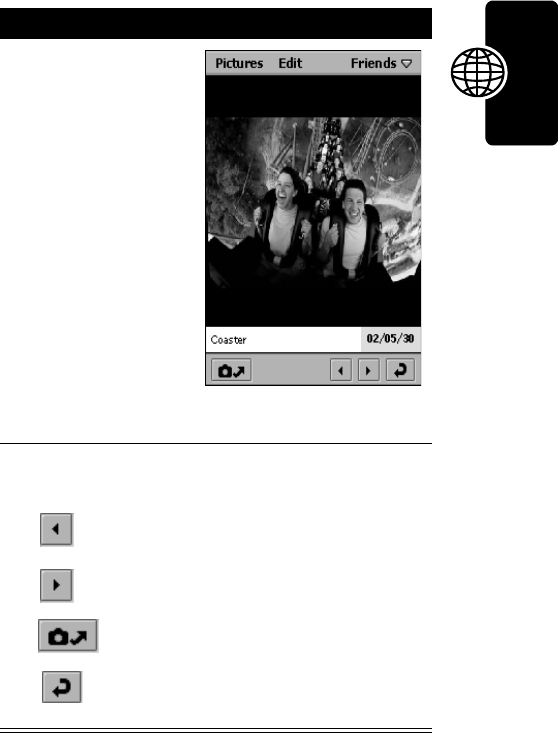
117
Draft
News and Entertainment
Viewing Pictures
Action
1
Tap the thumbnail
picture or file name
you want to view.
The picture
displays.
If the original
picture is larger
than the display
area, it reduces to
fit. To see the
picture in its
original size, tap
Pictures
>
Actual size
view
. Use
C
(center) to scroll to
see the entire picture.
2
While viewing the picture, you can tap the
following buttons at the bottom of the screen:
Tap to see previous picture.
Tap to see next picture.
Tap to open the Camera application.
Tap to return to the list or thumbnails of
pictures.

118
Draft
News and Entertainment
Viewing Slideshow
You can view all of the pictures in a folder as a slideshow.
Action
1
Open the folder with the pictures you want to
view.
2
Tap
Pictures
>
View slideshow
.
The pictures in the folder display in the order
listed.
Note:
The default interval between slides is
3 seconds. To change this interval, tap
Setting
>
Slideshow interval
before you start the slideshow.
If you select
Manual
mode, you must press
S
left
and right to move through the slideshow.

119
Draft
News and Entertainment
Editing Pictures
You can use
Pictures
to edit pictures in the following ways:
•
Rotate image
•
Draw on image
•
Add a stamp to the image
•
Add a frame to the image
To edit a picture, select the desired editing function from
the
Edit
menu. See the A1000 More Here reference guide
on the in-box CD for more information about editing
pictures.
Sending Pictures
You can send pictures by email, SMS message, MMS
message, or Bluetooth.
Action
1
Tap the thumbnail picture or file name you want
to send.
2
Ta p
Pictures
>
Send as
.
3
Select the method by which you want to send the
picture.
4
Ta p
Done
.
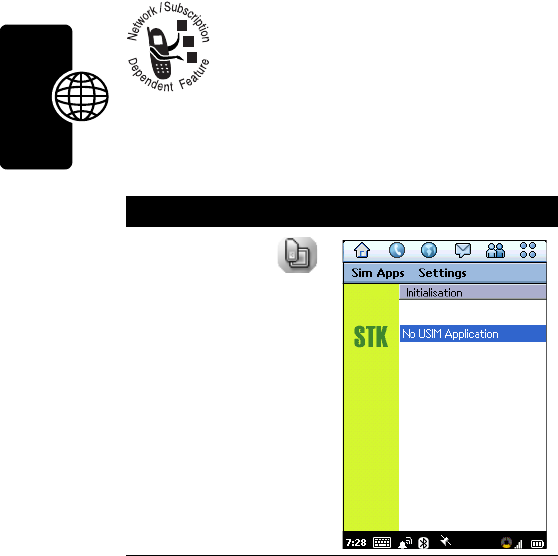
120
Draft
News and Entertainment
SIM Applications
(SimApps)
Your USIM card may contain additional
applications that process outgoing calls,
text messages, and other services.
Please contact 3 for additional
information.
Action
1
Tap SimApps ( )
in the Application
Launcher.

121
Draft
Specific Absorption Rate Data
Specific Absorption Rate Data
This model phone meets the international standards for exposure to
radio waves.
Your mobile phone is a radio transmitter and receiver. It is designed and
manufactured not to exceed limits for exposure to radio frequency (RF)
energy. These limits are part of comprehensive guidelines and establish
permitted levels of RF energy for the general population. The guidelines
are based on standards that were developed by independent scientific
organizations through periodic and thorough evaluation of scientific
studies. The guidelines include a substantial safety margin designed to
assure the safety of all persons, regardless of age and health.
The exposure standard for mobile phones employs a unit of measurement
known as the Specific Absorption Rate, or SAR. Under the guidelines for
your phone model, the SAR limit is 2.0 W/kg.
1
Tests for SAR are
conducted in accordance with CENELEC
2
testing procedures using
standard operating positions with the phone transmitting at its highest
certified power level in all tested frequency bands. Although the SAR is
determined at the highest certified power level, the actual SAR of the
phone while operating can be well below the maximum value. This is
because the phone is designed to operate at multiple power levels so as
to use only the power required to reach the network. In general, the closer
you are to a base station, the lower the power output of the phone.
Before a phone model is available for sale to the public, it is tested to
confirm compliance with the guidelines. The tests are performed in
1. The SAR limit recommended by international guidelines (ICNIRP) for mobile
phones used by the public is 2.0 watts/kilogram (W/kg) averaged over ten
grams of tissue. The limit incorporates a substantial margin for safety to give
additional protection for the public and to account for any variations in
measurements.
2. CENELEC is a European Union standards body.

122
Draft
positions that conform to a uniform testing methodology determined by an
expert standards body. The highest SAR value for this model phone when
tested for use at the ear is ____ W/kg.
1
While there may be differences between the SAR levels of various phones
and at various positions, they all meet the governmental requirements for
safe exposure. Please note that improvements to this product model
could cause differences in the SAR value for later products; in all cases,
products are designed to be within the guidelines.
1. Additional related information includes the Motorola testing protocol,
assessment procedure, and measurement uncertainty range for this product.

123
Draft
Warranty
Motorola Limited Warranty for
the United States and Canada
What Does this Warranty Cover?
Subject to the exclusions contained below, Motorola, Inc. warrants its
telephones, pagers, messaging devices, and consumer and professional
two-way radios (excluding commercial, government or industrial radios)
that operate via Family Radio Service or General Mobile Radio Service,
Motorola-branded or certified accessories sold for use with these
Products (“Accessories”) and Motorola software contained on CD-ROMs
or other tangible media and sold for use with these Products (“Software”)
to be free from defects in materials and workmanship under normal
consumer usage for the period(s) outlined below. This limited warranty is
a consumer's exclusive remedy, and applies as follows to new Motorola
Products, Accessories and Software purchased by consumers in the
United States or Canada, which are accompanied by this written
warranty:
Products and Accessories
Products Covered Length of Coverage
Products and Accessories
as
defined above, unless otherwise
provided for below.
One (1) year
from the date of
purchase by the first consumer
purchaser of the product unless
otherwise provided for below.
Decorative Accessories and
Cases
. Decorative covers,
bezels, PhoneWrap™ covers and
cases.
Limited lifetime warranty
for the
lifetime of ownership by the first
consumer purchaser of the
product.
Monaural Headsets.
Ear buds
and boom headsets that transmit
mono sound through a wired
connection.
Limited lifetime warranty
for the
lifetime of ownership by the first
consumer purchaser of the
product.

124
Draft
Exclusions
Normal Wear and Tear.
Periodic maintenance, repair and replacement of
parts due to normal wear and tear are excluded from coverage.
Batteries.
Only batteries whose fully charged capacity falls below 80% of
their rated capacity and batteries that leak are covered by this limited
warranty.
Abuse & Misuse.
Defects or damage that result from: (a) improper
operation, storage, misuse or abuse, accident or neglect, such as physical
damage (cracks, scratches, etc.) to the surface of the product resulting
from misuse; (b) contact with liquid, water, rain, extreme humidity or
heavy perspiration, sand, dirt or the like, extreme heat, or food; (c) use of
the Products or Accessories for commercial purposes or subjecting the
Product or Accessory to abnormal usage or conditions; or (d) other acts
which are not the fault of Motorola, are excluded from coverage.
Use of Non-Motorola Products and Accessories.
Defects or damage
that result from the use of Non-Motorola branded or certified Products,
Accessories, Software or other peripheral equipment are excluded from
coverage.
Unauthorized Service or Modification.
Defects or damages resulting
from service, testing, adjustment, installation, maintenance, alteration, or
modification in any way by someone other than Motorola, or its authorized
service centers, are excluded from coverage.
Consumer and Professional
Two-Way Radio Accessories.
Ninety (90) days
from the date of
purchase by the first consumer
purchaser of the product.
Products and Accessories that
are Repaired or Replaced.
The balance of the original
warranty or for ninety (90) days
from the date returned to the
consumer, whichever is longer.
Products Covered Length of Coverage

125
Draft
Altered Products.
Products or Accessories with (a) serial numbers or
date tags that have been removed, altered or obliterated; (b) broken seals
or that show evidence of tampering; (c) mismatched board serial
numbers; or (d) nonconforming or non-Motorola housings, or parts, are
excluded from coverage.
Communication Services.
Defects, damages, or the failure of Products,
Accessories or Software due to any communication service or signal you
may subscribe to or use with the Products Accessories or Software is
excluded from coverage.
Software
Exclusions
Software Embodied in Physical Media.
No warranty is made that the
software will meet your requirements or will work in combination with any
hardware or software applications provided by third parties, that the
operation of the software products will be uninterrupted or error free, or
that all defects in the software products will be corrected.
Software NOT Embodied in Physical Media.
Software that is not
embodied in physical media (e.g. software that is downloaded from the
internet), is provided “as is” and without warranty.
Who is Covered?
This warranty extends only to the first consumer purchaser, and is not
transferable.
What Will Motorola Do?
Motorola, at its option, will at no charge repair, replace or refund the
purchase price of any Products, Accessories or Software that does not
conform to this warranty. We may use functionally equivalent
Products Covered Length of Coverage
Software.
Applies only to physical defects
in the media that embodies the copy of the
software (e.g. CD-ROM, or floppy disk).
Ninety (90) days
from
the date of purchase.

126
Draft
reconditioned/refurbished/pre-owned or new Products, Accessories or
parts. No data, software or applications added to your Product, Accessory
or Software, including but not limited to personal contacts, games and
ringer tones, will be reinstalled. To avoid losing such data, software and
applications please create a back up prior to requesting service.
How to Obtain Warranty Service or Other
Information
You will receive instructions on how to ship the Products, Accessories or
Software, at your expense, to a Motorola Authorized Repair Center. To
obtain service, you must include: (a) a copy of your receipt, bill of sale or
other comparable proof of purchase; (b) a written description of the
problem; (c) the name of your service provider, if applicable; (d) the name
and location of the installation facility (if applicable) and, most importantly;
(e) your address and telephone number.
What Other Limitations Are There?
ANY IMPLIED WARRANTIES, INCLUDING WITHOUT LIMITATION THE
IMPLIED WARRANTIES OF MERCHANTABILITY AND FITNESS FOR A
PARTICULAR PURPOSE, SHALL BE LIMITED TO THE DURATION OF
THIS LIMITED WARRANTY, OTHERWISE THE REPAIR,
REPLACEMENT, OR REFUND AS PROVIDED UNDER THIS EXPRESS
LIMITED WARRANTY IS THE EXCLUSIVE REMEDY OF THE
CONSUMER, AND IS PROVIDED IN LIEU OF ALL OTHER
USA
Phones
1-800-331-6456
Pagers
1-800-548-9954
Two-Way Radios
and Messaging Devices
1-800-353-2729
Canada
All Products
1-800-461-4575
TTY
1-888-390-6456
For
Accessories
and
Software
, please call the telephone number
designated above for the product with which they are used.
127
Draft
WARRANTIES, EXPRESS OR IMPLIED. IN NO EVENT SHALL
MOTOROLA BE LIABLE, WHETHER IN CONTRACT OR TORT
(INCLUDING NEGLIGENCE) FOR DAMAGES IN EXCESS OF THE
PURCHASE PRICE OF THE PRODUCT, ACCESSORY OR SOFTWARE,
OR FOR ANY INDIRECT, INCIDENTAL, SPECIAL OR
CONSEQUENTIAL DAMAGES OF ANY KIND, OR LOSS OF REVENUE
OR PROFITS, LOSS OF BUSINESS, LOSS OF INFORMATION OR
DATA, SOFTWARE OR APPLICATIONS OR OTHER FINANCIAL LOSS
ARISING OUT OF OR IN CONNECTION WITH THE ABILITY OR
INABILITY TO USE THE PRODUCTS, ACCESSORIES OR SOFTWARE
TO THE FULL EXTENT THESE DAMAGES MAY BE DISCLAIMED BY
LAW.
Some states and jurisdictions do not allow the limitation or
exclusion of incidental or consequential damages, or limitation on
the length of an implied warranty, so the above limitations or
exclusions may not apply to you. This warranty gives you specific
legal rights, and you may also have other rights that vary from state
to state or from one jurisdiction to another.
Laws in the United States and other countries preserve for Motorola
certain exclusive rights for copyrighted Motorola software such as the
exclusive rights to reproduce and distribute copies of the Motorola
software. Motorola software may only be copied into, used in, and
redistributed with, the Products associated with such Motorola software.
No other use, including without limitation disassembly of such Motorola
software or exercise of the exclusive rights reserved for Motorola, is
permitted.

128
Index
Numerics
3 key 27
A
A1000 desktop suite
connecting to computer
74
installing 24
A1000 desktop top suite 71
accessories 16
accounts
email 51
MMS 51
SMS 51
adding folders 31
airplane mode
status bar indicator 33
turning on and off 34, 49
alarms
calendar 82
responding to 91
setting 91
to do 86
turning sound off 92
alert mode 32
changing 32
status bar indicator 32
answering calls 25, 48
application
icons 29
opening 28
shortcuts 39
application launcher 28
application selector bar 26
application space 26
appointments 81
attachments, opening 57
AU files 100
audio mode indicator 32
B
battery
charging 22
extending battery life 20
installing 21
strength indicator 34
battery cover
removing 18
replacing 22
Bluetooth 74
status bar 32
bookmark
adding 98
opening 98
box contents 16
brightness
129
screen 66
button bar 26
C
calculator 92
calendar 81
adding an entry 81
alarm, setting 82
entry types 81
moving entries to to do
84
private entries 83
recurring entries 83
views 83
calibrate screen 24
call
video 43
calls
answering 25, 48
dialing with keypad 43
emergency 46
making 25
ring tones 68
to stored contacts 64
vibrate pattern 69
video 43
voice 43
camera
control keys 108
front and back lens 108
landscape view 114
memory available 111
opening application 107
portrait view 114
self-timer 110
settings 109
taking still pictures 109
charging battery
travel charger 22
clock 31
computer
linking to 74
contact fields
adding new 61
contacts
adding 59
calling 64
fields 61
opening application 58
pictures, assigning 61
preferred phone number
59
ring tone, assigning 60
saving to USIM card 59
sending messages to 64
D
data call
wireless connection 74
day view 83
deleting
folders 31
desktop suite
installing 24
130
dialing
stored numbers 43, 64
using keypad 43
display
brightness 66
calibration 67
described 26
wallpaper 66
downloading
files 99
E
earpiece
volume, adjusting 42
email
account 51
opening attachments 57
receiving 57
sending 53
sending to contact 64
status bar indicator 33
emergency
making calls 46
status bar indicator 33
F
files
adding to MMS 55
attaching to email and
SMS 53
downloading from web
99
saving audio 106
saving video 115
sending 115, 119
folders 30
G
game keys 28
GPRS 33
GPS 32, 49
GSM 33
H
handwriting recognition 34
home screen
displaying 38
personalizing 40
I
icons
applications 29
status bar 31
information snacks 39
installing
battery 21
memory card 19
USIM card 17
internal speakerphone 42
internet
opening web pages 98
131
K
keyboard
launcher 32
using 36
keys
camera 108
center select 27
game 28
Hutchison 27
navigation 27
Power 23
speakerphone 42
volume 42
L
landscape view 114
language
selecting 24
location service
status bar indicator 32
turning on and off 32
location, time zone 90
locking communicator 95
M
making a call 25
memory available, camera
111
memory card
installing 19
saving audio files to 106
saving video files to 115
menu bar 26
messages
accounts 50
opening application 52
opening attachments 57
receiving 57
ring tones 69
sending 53
status bar indicator 33
vibrate pattern 69
MIDI files 100
MMS
maximum size 56
receiving 57
sending 54
status bar indicator 33
month view 83
MP3 files 100
Multimedia Message
Service.
See
MMS
music
file types supported 100
managing playlists 103
opening 100
playing playlists 104
playing tracks 101
saving files 106
mute
status bar indicator 32
132
N
navigation key 27
network
status bar indicator 33
notes
drawing sketches 88
writing notes 88
O
opening applications 28
optional accessories,
defined 17
optional features, defined
17
P
password
setting protection level 95
personal information 39
phone
airplane mode 49
answering calls 25, 48
dialing with keypad 43
displaying own number
42
keypad display 41
making video calls 43
making voice calls 25, 43
opening application 41
status bar indicator 32
wireless connection 74
phone number
dialing with keypad 43
storing in contact list 59
viewing your own 42
Picsel Viewer 100
pictures
assigning to contacts 61
opening application 116
slideshow 118
taking with camera 109
viewing 117
viewing pictures 117
playing
audio tracks 101
video clips 113
portrait view 114
power
key 23
turning on and off 23
private
calendar entries 83
to do entries 86
R
recording
video clips 110
recording voice tags 62
reminders 81
ring tones
assigning to contacts 60
choosing for calls 68
133
choosing for messages
69
ringing
choosing tones 68
turning off 49
roaming
status bar indicator 33
S
saving
audio files 106
video files 115
screen
brightness 66
calibrating 67
security
locking communicator 95
password protection 95
self-timer, camera 110
sending
messages 53
pictures 119
video clips 115
short message service,
SMS 50
shortcut key
setting application 68
signal strength indicator 34
silent mode indicator 32
sim applications 120
SIM card.
See
USIM card
sketching 88
slideshow 118
SMS
receiving 57
sending 53
status bar indicator 33
snacks 39
sounds, system 67
speakerphone
turning on/off 42
using 42
status bar 26, 31
storing
email address 59
phone numbers 59
streaming video 114
stylus 27
switching folders 30
system sounds 67
T
text entry 34
time
alarms 91
to do
adding entries 85
alarm 86
deleting entries 87
due dates 85
marking tasks as
complete 86
moving entries to
Calendar 87
134
private entries 86
touchscreen 27
U
UMTS 33
unlocking communicator 95
USIM card
installing 17
saving contacts to 59
V
vibrate mode
indicator 32
turning on and off 32
vibrate pattern 69
video
opening application 112
playing clips 113
saving files 115
sending clips 115
video calls
calling computers 45
dialing with keypad 44
video clips
playing 113
virtual keyboard 36
voice calls 43
voice message indicator 32
voice records 92
deleting 94
playback 94
sending 94
voice tags
recording 62
volume
adjusting 42
key 42
W
wallpaper 66
warranty 123
WAV files 100
web
downloading files 99
opening pages 98
saving bookmarks 99
saving viewed pages 99
week view 83
WMA files 100
writing
using stylus 34
using virtual keyboard 36
U.S. patent Re. 34,976
135